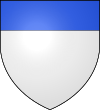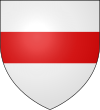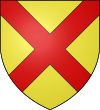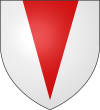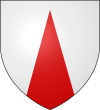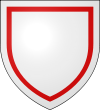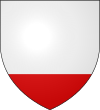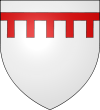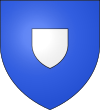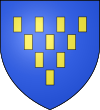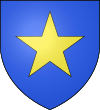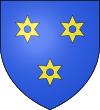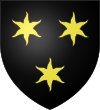| Revision as of 01:28, 2 March 2005 edit141.219.44.44 (talk) →Humans: maiden← Previous edit | Latest revision as of 14:09, 27 December 2024 edit undoMaterialscientist (talk | contribs)Edit filter managers, Autopatrolled, Checkusers, Administrators1,994,292 editsm Reverted edits by 92.233.179.5 (talk): not providing a reliable source (WP:CITE, WP:RS) (HG) (3.4.12)Tags: Huggle Rollback | ||
| Line 1: | Line 1: | ||
| {{Short description|Heraldic motif}} | |||
| In ], a '''charge''' is the image that occupies the ] on an ] (or shield). The most common charges, or "ordinaries," are geometric constructs such as ]es and ]s. Other charges include ]s, ]s, astronomical objects and tools ranging from those of ancient vintage to ]s, ]s (the arms of ] specify a "]"), a ] (in the arms of ]). "Atomic" charges have also occurred in recent heraldry (see "]"). The ordinaries are sometimes called "proper charges," with other charges being known as "common charges." ''Charge'' can also be used as a verb; for example, if an escutcheon bears three ]s, then it is said to be "charged with three lions." It is important to distinguish between ] and charges, and to note that charges can themselves be charged with a superposed image. | |||
| {{COA elements}} | |||
| Most armorial achievements include charges, but a few only have a plain ] (or colour) without any device, or a simple division or pattern of the field. The charges are either in one or more of the tinctures, or ''umbrated'', supposedly represented as a ], though the representation is closest to an outline alone (an example of similar terminology applied to the "shadows" of a charge are the arms of Risoul, | |||
| Hautes Alpes, France). Charges that were chosen as a pun on the name of the armiger are called "canting arms", and while this largely 15th and 16th century practice survives, charges are less commonly chosen now for their supposed or actual symbolism than formerly (the lion symbolising courage, for example). Recently granted charges are more likely to be chosen for some connection with the career or interests of the grantee, or for aesthetic purposes. Charges need not have any attached meaning. | |||
| In ], a '''charge''' is any emblem or device occupying the ] of an '']'' (shield). That may be a geometric design (sometimes called an '']'') or a symbolic representation of a person, animal, plant, object, building, or other device. In French ], the ordinaries are called ''pièces'', and other charges are called ''meubles'' (" mobile "). | |||
| A charge is said to be "throughout" when it is shown as touching the edges of the shield when this is not its default position. | |||
| The term ''charge'' can also be used as a verb; for example, if an escutcheon depicts three ]s, it is said to be ''charged with three lions''; similarly, a crest or even a charge itself may be "charged", such as a pair of eagle wings ''charged with trefoils'' (as on the ]). It is important to distinguish between the ordinaries and ], as they typically follow similar patterns, such as a shield ''divided'' "per chevron", as distinct from being ''charged with'' a ]. | |||
| In later times there are rare instances of charges "in ]," highlighting that the default tendency is to ignore perspective in the treatment of charges. | |||
| While thousands of objects found in religion, nature, mythology, or technology have appeared in armory, there are several charges (such as the cross, the eagle, and the lion) which have contributed to the distinctive flavour of heraldic design. Only these and a few other notable charges (crowns, stars, keys, etc.) are discussed in this article. | |||
| A charge of rectangular form is said to be ''arraswise'' when a corner is in front and two sides are visible. | |||
| In addition to being shown in the regular way, charges may be blazoned as ''umbrated'' (shadowed), ''detailed'',{{efn|As in the coat of arms of the 432d Reconnaissance Group of the United States Air Force.{{sfnp|Maurer|1983|p=303}}}} (rather incorrectly) ''outlined'',{{sfnp|Maurer|1983|p=393}} highly unusually ''shaded''{{sfnp|Maurer|1983|p=21}} and rather irregularly ''in silhouette'' or, more ambiguously, confusingly, and unhelpfully, ''futuristic'',{{sfnp|Maurer|1983|p=261}} ''stylized'' or ''simplified''.<ref>{{cite web |url=http://www.tioh.hqda.pentagon.mil/Catalog/HeraldryMulti.aspx?CategoryId=10275&grp=2&menu=Uniformed |title=961st Engineer Battalion |archive-url=https://web.archive.org/web/20160813200534/http://www.tioh.hqda.pentagon.mil/Catalog/HeraldryMulti.aspx?CategoryId=10275&grp=2&menu=Uniformed |archive-date=2016-08-13 }}</ref> There are also several units in the ] with charges blazoned as "mythical",{{sfnp|Maurer|1983|p=339}} or beasts as "chimerical",{{sfnp|Maurer|1983|p=163}} but those conceptions are meaningless and irrelevant to the conception of heraldry, and it does not affect the appearance of those charges. | |||
| ==Proper charges== | |||
| Heraldic writers have, somewhat arbitrarily, distinguished between "honourable ordinaries" and "sub-ordinaries." It is often said that only nine charges are "honourable ordinaries," but exactly which nine fit into this category is a subject of disagreement. It is sometimes said that only those ordinaries each of whose widths is one-fifth or more of the total width of the escutcheon is "honourable." | |||
| == Ordinary charges – Ordinaries and sub-ordinaries{{anchor|Ordinaries and sub-ordinaries}} == | |||
| Narrower or smaller versions of these ordinaries are called "]s." Many have two diminutives, the first with half the width of the original, and the second with quarter the width of the original. | |||
| {{main article|Ordinary (heraldry)}} | |||
| Unlike ''mobile charges'', the '''''ordinary charges'''''<ref name="uklo"> on ''www.uklo.org''</ref> reach to the edge of the field. Some heraldic writers{{efn|Woodcock, himself apparently one such author, lists Leigh, Holme, Guillim and Edmondson among these, while other prominent authors such as Fox-Davies shun the distinction as an arbitrary and unuseful practice.}} distinguish, albeit arbitrarily, between '''''(honourable) ordinaries''''' and '''''sub-ordinaries'''''. While some authors hold that only nine charges are "honourable" ordinaries, exactly which ones fit into this category is a subject of constant disagreement. The remainder are often termed ''sub-ordinaries'', and narrower or smaller versions of the ordinaries are called ''diminutives''. While the term ''ordinaries'' is generally recognised, so much dispute may be found among sources regarding which are "honourable" and which are relegated to the category of "sub-ordinaries" that indeed one of the leading authors in the field, ] (1871–1928), wrote at length on what he calls the "utter absurdity of the necessity for any classification at all", stating that the ordinaries and sub-ordinaries are, in his mind, "no more than first charges".<ref name=Fox-Davies107>{{harvp|Fox-Davies|1909|p=107}}</ref> Apparently ceding the point for the moment, Fox-Davies lists the generally agreed-upon "honourable ordinaries" as the bend, fess, pale, pile, chevron, cross, saltire, and chief.<ref name=Fox-Davies107 /> Woodcock sheds some light on the matter, stating that earlier writers such as Leigh, Holme and Guillim proposed that "honourable ordinaries" should occupy one-third of the field, while later writers such as Edmondson favoured one-fifth, "on the grounds that a bend, pale, or chevron occupying one-third of the field makes the coat look clumsy and disagreeable".<ref name=Woodcock58>{{harvp|Woodcock|Robinson|1988|p=58}}</ref> Woodcock goes so far as to enumerate the ordinaries thus: "The first Honourable Ordinary is the cross", the second is the chief, the third is the pale, the fourth is the bend, the fifth is the fess, the sixth is the inescutcheon, the seventh is the chevron, the eighth is the saltire, and the ninth is the bar, while stating that "some writers" prefer the bordure as the ninth ordinary.<ref>{{harvp|Woodcock|Robinson|1988|pp=58-61}}</ref> Volborth, having decidedly less to say on the matter, agrees that the classifications are arbitrary and the subject of disagreement, and lists the "definite" ordinaries as the chief, pale, bend, fess, chevron, cross and saltire.<ref>{{harvp|von Volborth|1981|pp=18-19}}</ref> Boutell lists the chief, pale, bend, bend sinister, fess, bar, cross, saltire and chevron as the "honourable ordinaries".<ref>{{harvp|Boutell|1890|p=20}}</ref> Thus, the chief, bend, pale, fess, chevron, cross and saltire appear to be the undisputed ordinaries, while authors disagree over the status of the pile, bar, inescutcheon, bordure and others. | |||
| ===Honourable |
===Honourable ordinaries=== | ||
| Several different figures are recognised as ''honourable ordinaries'', each normally occupying about one-fifth to one-third of the field.<ref name=Woodcock58 /> As discussed above, much disagreement exists among authors regarding which ordinary charges are "honourable", so only those generally agreed to be "honourable ordinaries" will be discussed here, while the remainder of ordinary charges will be discussed in the following section. | |||
| Several different figures are recognised as honourable ordinaries. The '']'' is a horizontal stripe at the top of the field. Similar to it are the '']'', a horizontal stripe in the centre of the field, and the '']'', which is of an indeterminate width, but if borne singly supposed to be slightly thinner than a fess. The vertical equivalent of the fess is the '']''. The diagonal equivalents are the '']'' (running from the upper left to the lower right, as <b>\</b> , as perceived by the viewer) and the ''bend sinister'' (running from the upper right to the lower left, as <b>/</b> ). A chief, fess or pale occupies one-third of the field; a bar, bend or bend sinister occupies one-fifth of the field. | |||
| * The '']'' is the upper portion of the field. | |||
| The '']'' is a geometric construction of two perpendicular lines, and is sometimes referred to as the "noblest" of the honourable ordinaries. There are several variants, such as ]es and ]es. Of these variants, only the ''saltire'' (a ] or ]-shaped construction) is considered an ordinary in its own right. The size of each depends on whether or not the ordinary itself bears another charge; if it is charged, the width is one-third the width of the field, and if it is uncharged, the width is one-fifth the width of the field. | |||
| * The '']'' is a stripe running from the upper left to the lower right, as '''\''', as seen by the viewer. The ''bend sinister'' runs from the upper right to the lower left, as '''/'''. (In heraldry ''sinister'' (Latin: left) refers to the left side of the shield from the perspective of the one wearing it, hence the right side from the viewer's perspective.) | |||
| * The '']'' is a vertical stripe in the centre of the field. | |||
| * The '']'' is a broad horizontal stripe across the centre of the field. | |||
| * The '']'' is a construction shaped like an inverted letter '''V'''. | |||
| * The '']'' is a geometric construction of two perpendicular lines or bands, vertical and horizontal. It has hundreds of variants, most of which are mobile charges rather than ordinaries; some of these will be discussed below. | |||
| * The '']'' is a diagonal cross, often called ''Saint Andrew's cross''. | |||
| Most of the ordinaries have corresponding ''diminutives'', narrower versions, most often mentioned when two or more appear in parallel: ''bendlets, pallets, bars'' (multiples of the ''fess''), and ''chevronels''. | |||
| The '']'' is a construction shaped like an inverted ] ]; the '']'', similarly, is shaped like the letter ]. (There is a T-shaped charge, the ], which is not understood to be an ordinary.) The '']'' is a triangle, whose base lies along the top of the field, and whose vertex lies in the centre of the bottom half of the field. The '']'' is a rectangle occupying the top left quarter of the field, as perceived by the viewer. The '']'' is a ''diminutive'' of the quarter, occupying in theory one-ninth of the area of the field, being as deep as the chief, which theoretically occupies one-third of the area of the field, but occupies the dexter third of this. A quarter or canton on the left side of the field is called a ''quarter sinister'' or ''canton sinister''. | |||
| <gallery class="center" widths="100px"> | |||
| Care must be taken in blazoning when two or more ordinaries or subordinaries, or diminutives thereof, are depicted ''conjoined''. | |||
| File:Argent a chief azur.svg|Chief | |||
| File:Bend demo.svg|Bend | |||
| File:Ecu d'argent au pal de sable.svg|Pale | |||
| File:Fess demo.svg|Fess | |||
| File:Chevron demo 2.svg|Chevron | |||
| File:Blason-argent-croix-gueules.svg|Cross | |||
| File:Blason d'or au sautoir de gueules.svg|Saltire | |||
| </gallery> | |||
| ===Honourable ordinaries or sub-ordinaries=== | |||
| ===Sub-Ordinaries=== | |||
| In addition to those mentioned in the above section, the following are variously called "honourable ordinaries" by different authors, while others of these are often called ''sub-ordinaries''. | |||
| In addition to those mentioned in the above section whose status as honourable ordinaries is disputed, there are several other charges recognised as sub-ordinaries. The ''inescutcheon'' is a small shield placed in the centre of the field, and general practice, if not strictly speaking a "rule," suggests that it be the same shape as the shield it is on, though shields of specific shapes are rarely specified. The ''bordure'' is, as the name suggests, a border touching the edge of the field. Related to the bordure is the ''orle'', a narrow border within the field. Unlike the bordure, the orle does not touch the edges of the field. | |||
| * The '']'' is a border touching the edge of the field. | |||
| * The '']'' is a wedge issuing from the top of the field and tapering to a point near the bottom. Its length and width vary widely. Piles may occur in any orientation, e.g. ''pile reversed'', ''pile bendwise'' and so on. | |||
| * The '']'' or ''pairle'' is shaped like the letter '''Y'''. | |||
| <gallery class="center" widths="100px"> | |||
| There are several diamond-shaped sub-ordinaries, including the ''lozenge'' and the ''fusil'' (which is thinner and longer than the lozenge). If a lozenge is "voided" or empty, it is called a ''mascle''; if it appears to have a circular hole within it, it is called a ''rustre''. The ''fret'' is an interlaced pattern of a mascle and two diagonal bands. | |||
| File:Blason ville fr Le Born (Haute-Garonne).svg|Bordure | |||
| Pile demo.svg|Pile | |||
| File:Pile reversed demo.svg|Pile reversed | |||
| File:Blason Marsal.svg|Pall | |||
| </gallery> | |||
| ===Sub-ordinaries=== | |||
| The ''gyron'' is a ] placed in the dexter chief of the field. A gyron is shaped like the lower left half of a canton. A similar figure found in the sinister chief is called a ''gyron sinister''. (''Demi-gyrons'' are found in the arms of the ].) The ''flanch'', also called the ''flaunch'', is a curved figure (somewhat shaped like a part of a ]) that is placed along the dexter or sinister edges of the field. Flanches are always found in pairs, one on either side of the field. A ''label'' is a horizontal strap, with a number of pendants suspended therefrom. The default number of pendants is three; another number may be specified in the blazon. This is almost invariably a greater number, though there is allegedly a unique instance of a label with only one pendant. | |||
| * The '']'' is a rectangle occupying the top left quarter of the field, as seen by the viewer. | |||
| * The '']'' is a square occupying the left third of the chief (sometimes reckoned to be a diminutive of the quarter). | |||
| * The '']'' may be considered an inner bordure: a reasonably wide band away from the edge of the shield, it is always shown following the shape of the shield, without touching the edges. | |||
| **The '']'' is a narrower version of the orle, rarely seen except in the ''double tressure flory and counter-flory'', an element of the ] and of many other Scots coats. | |||
| * The ''base'' or ''terrace in base'' is the lower portion of the field. | |||
| * The ''fret'' originally consisted of three bendlets interlaced with three bendlets sinister; other depictions form the outer bendlets into a mascle through which the two remaining bendlets are woven. This has also been called a Harington knot, as in the arms of Harington.<ref>{{harvp|Clark|1892|p=16}}</ref> | |||
| * '']es'', ''flanches'' or ''flasks'' are regions on the sides of the field, bounded by a pair of circular arcs whose centers are beyond the sides of the shield. | |||
| * A '']'' is a horizontal strap, with a number of pendants (usually called ''points'') suspended from it; the default is three, but any number may be specified. The label is nearly always a mark of ] in British and French heraldry,{{efn|text=Marks of cadency differ from country to country, but are largely the same in Britain and France, and similar in other European countries outside of the German-speaking (and Nordic) countries, where brisures on the shield were less common and different crests were often adopted to indicate the difference.{{sfnp|von Volborth|1981|p=76}} It should also be noted that the English system of cadency, by which the use of the label to indicate the first son is best known, was not developed until the ].{{sfnp|Woodward|Burnett|1894| p=444}}}} but is occasionally found as a regular charge in early armory and even in the 20th century. It is sometimes called a ''file'', as in the canting arms of Belfile, a label with a bell hanging from each point. There are some examples in which the strap is omitted, the points issuing from the top of the shield.{{efn|See the arms of William de Valence, Earl of Pembroke in {{harvtxt|Fox-Davies|1909|loc=fig. 120}} for an example of this.}} | |||
| * The ''gyron'' is a ] occupying the lower half of the first quarter: its edges follow per bend and per fess from the dexter side to the centre of the field. A ''gyron sinister'', much rarer, is a similar figure in the sinister chief. Gyrons are sometimes blazoned to be shown in other positions – as in 'the sun in his splendour .. along with in dexter base a sixth gyron voided' <!-- what does 'sixth gyron' mean and what's the source? --> | |||
| <gallery class="center" widths="100px"> | |||
| The ''billet'' is a rectangle (the length being twice the width). The short sides of the rectangle are at the top and bottom, and the long sides are on the right and left. (It is important to distinguish the billet from the ], a ] charge that when occurring singly and in one of the ]s in supposed to be an ]. The delf is distinguished from the square, which rarely occurs, the arms of ], ], ] including "a square... joined at each corner with a smaller square Vert".) A circular ring is called an ''annulet''; a circle is called a ''roundel''. Roundels have different names depending on their tincture. A gold circle is a ''bezant'', a silver circle a ''plate'', a red circle a ''torteau'', a blue circle a ''hurt'', a black circle an ''ogress'' or ''pellet'', a greem circle a ''pomme'', a purple circle a ''golpe'', an orange circle an ''orange'' and a blood-red circle a ''guze''. Furthermore, if the circle is ''barry wavy argent and azure'' (so that it appears as blue and white waves), then it is called a ''fountain'' or ''syke''. | |||
| File:Quarter demo.svg|Quarter | |||
| File:Canton demo.svg|Canton | |||
| File:Orle demo.svg|Orle | |||
| File:Champagne demo.svg|Base | |||
| File:Earl of Dysart COA.svg|Fret | |||
| File:Flaunches demo.svg|Flaunches | |||
| File:Ecu d'argent à un lambel à cinq pendants de gueules.svg|Label | |||
| File:Gyron demo.svg|Gyron | |||
| </gallery> | |||
| == Mobile charges{{anchor|Common charges}} == | |||
| ===Diminutives=== | |||
| The so-called '''''mobile charges'''''<ref name="uklo" /> (or sometimes '''''common charges''''') are not tied to the size and shape of the shield, and so may be placed in any part of the field, although whenever a charge appears alone, it is placed with sufficient position and size to occupy the entire field. Common ''mobile charges'' include ] figures, human parts, ]s, animal parts, ]s (or "]s"), ]s and floral designs, inanimate objects, and other devices. The heraldic animals need not exactly resemble the actual creatures. | |||
| Ordinaries have diminutives, or charges of the same pattern but of smaller sizes. A charge one-half the size of the ordinary is called a ''closet'' in the case of a bar, a ''pallet'' in the case of a pale, and a ''chevronnel'' in the case of a chevron. (There are occasional mentions of a "narrow pallet," but this is not considered to be a diminutive.)) A charge one-fourth the size of the ordinary is called a ''barrulet'' in the case of a bar, an ''endorse'' in the case of a pale, and a ''couple close'' in the case of a chevron. Cotises, the endorse, and the couple close cannot be borne singly, but must be born on either side of, and close to, the associated ordinary, in which case the ordinary is said to be ''cotised''. | |||
| === Geometric charges ===<!-- not sure about that name of this section --> | |||
| Bends and bends sinister have another system of nomenclature for their diminutives. A stripe half as large as a bend is a ''bendlet'' or ''garter'', one that is a fourth as large is a ''cotsie'', and one that is an eighth as large is a ''riband''. Similarly, a stripe half as large as a bend sinister is a ''scarpe'', and one that as a fourth as large is a ''fissure''. A stripe half the size of a bend, but cut off at the ends (so that it does not reach the corners of the field) is called a ''baton''; the equivalent for a bend sinister is a ''baton sinister''. One must distinguish this ''baton'' from the type of baton in the arms of ]. | |||
| A number of geometric charges are sometimes listed among the subordinaries (see above), but as their form is not related to the shape of the shield – indeed they may appear independent of the shield (''i.e.'' in ] and ]) – they are more usefully considered here. These include the escutcheon or inescutcheon, lozenge, fusil, mascle, rustre, billet, roundel, fountain, and annulet. | |||
| * The '']'' is a small shield. If borne singly in the centre of the main shield, it is sometimes called an ''inescutcheon'', and is usually employed to combine multiple coats. It is customarily the same shape as the shield it is on, though shields of specific shapes are rarely specified in the blazon. | |||
| * The '']'' is a ] generally resembling the ] of playing cards. | |||
| ** The ''fusil'': A more acute lozenge. | |||
| ** The ''mascle'': A lozenge voided (''i.e.'' with a lozenge-shaped hole). | |||
| ** The ''rustre'': A lozenge pierced (''i.e.'' with a round hole). | |||
| * The ''billet'' is a rectangle, usually at least twice as tall as it is wide; it may represent a ] or a sheet of paper. Billets appear in the shield of the ], which was modified to become that of the ]. | |||
| * The '']'' is a solid circle, frequently of gold (blazoned a '']''). | |||
| ** A '']'' is depicted as ''a roundel barry wavy argent and azure''. | |||
| ** An '']'' is a roundel voided (''i.e.'' a ring). | |||
| <gallery class="center" widths="100px"> | |||
| The diminutive of the chief is sometimes stated to be the ''fillet'', but this is a controversial position. The diminutives of the cross, saltire and pall are the ''fillet cross'', the ''fillet saltire'' and ''fillet pall'', respectively. These diminutives are one-fourth the sizes of the honourable ordinaries. The fess does not have a diminutive; it is sometimes suggested that bars are diminutives of fesses, but they are most often regarded as honourable ordinaries in their own right. A similar situation applies to the quarter and canton, though both the quarter and canton are often considered sub-ordinaries. | |||
| File:Blason-azur-écusson-argent.svg|Escutcheon | |||
| File:Lozenge_demo.svg|Lozenge | |||
| File:Blason ville fr Douzens (Aude).svg|Fusil | |||
| File:Blason fam fr du Puy du Fou.svg|Mascles | |||
| File:Blason ville fr Courris (Tarn).svg|Rustre | |||
| File:Blason-azur-10-billettes-or.svg|Billets | |||
| File:Blason-gueules-3-besants-or.svg|Roundels (bezants) | |||
| File:Fontana coa.svg|Fountain | |||
| File:Blason-azur-3-annelets-or.svg|Annulets | |||
| </gallery> | |||
| Several other simple charges occur with comparable frequency. These include the mullet or star, crescent and cross: | |||
| Most sub-ordinaries do not have diminutives. Though there are occasional anomalous appearances of "a narrow border," such as in the new arms of South Africa (see below), this is not regarded as a diminutive of the bordure. The diminutive of the orle is the ''tressure''; the latter's width is one-half the former's width. Tressures are usually found in pairs, and are known as ''double tressures''. The flaunch also has a diminutive half its size, known as the ''voider'', and there is another diminutive called the ''flasque,'' but these are largely theoretical, as these diminutives are no longer used. | |||
| * The '']'' is a star of (usually five) straight rays, and may have originated as a representation of the ''rowel'' or ''revel'' of a '']'' (although "spur revels" do appear under that name).<ref name=Fox-Davies296>{{harvp|Fox-Davies|1909|pp=295-296}}</ref> Mullets frequently appear pierced. An unpierced mullet is sometimes called a "star" in Scottish heraldry, and stars also appear in English and continental heraldry under that name (often with six points). The "spur revel" is also found in Scottish heraldry. | |||
| ** The ''estoile'': A star with (usually six) wavy rays is called an ''estoile'' (the ] word for 'star'; modern French ''étoile''). | |||
| * The '']'' is shown as a mullet with a bendwise wavy tail, rather than naturalistically. | |||
| * The '']'', a symbol of the ], normally appears with its horns upward; if its horns are ''to dexter'' it represents a waxing moon (''increscent''), and with horns ''to sinister'' it represents a waning moon (''decrescent''). | |||
| <gallery class="center" widths="100px"> | |||
| ==Common charges== | |||
| File:Blason-azur-étoile-or.svg|Mullet | |||
| Common charges include animals, whether land animals, fish or birds. The heraldic depictions need not, and usually do not, exactly resemble the actual creatures. Mythical creatures used in heraldry are sometimes called "monsters." Inanimate objects are also used; many of them resemble flowers and floral designs. | |||
| File:Blason-azur-3-molettes-or.svg|Mullets pierced | |||
| File:Wigton of Yorkshire arms.svg|Estoiles | |||
| File:Wappen Klettgau-Buehl.png|Hexagram | |||
| File:Blason ville fr Arguel 25.svg|Comet | |||
| File:Blason Jean Leliwa (selon Gelre).svg|Star and crescent | |||
| </gallery> | |||
| * The '']'': One of the most frequently found charges in heraldry, if not ''the'' most, is the cross, which has developed into, some say, 400 varieties.<ref>{{harvp|Fox-Davies|1909|p=127}}</ref> When the cross does not reach the edges of the field, it becomes a mobile charge. The plain ''Greek cross'' (with equal limbs) and ''Latin cross'' (with the lower limb extended) are sometimes seen, but more often the tip of each limb is developed into some ornamental shape. The most commonly found crosses in heraldry include the ''cross botonny'', the ''cross flory'', the ''cross moline'', the ''cross potent'', the ''cross patée'' or ''formée'', the ''cross patonce'' and the ''cross crosslet''.<ref>{{harvp|Fox-Davies|1909|pp=128-9}}</ref> | |||
| ===Supernatural or Divine beings=== | |||
| Though the taboo is not invariably respected, British heraldry in particular, and to a greater or lesser extent the heraldry of other countries, frowns on depictions of ] or ], though an exception may be in the not-uncommon Continental depictions of ]. The ] is shown on the arms of Breil, Graubünden, Switzerland, and show "the Virgin, St. John the Apostle and St. Mary Magdalene lamenting the body of Christ taken down from the Cross". | |||
| <gallery class="center" widths="100px"> | |||
| The goddess ] appears in the arms of the South-African town of that name. | |||
| File:Cross-Bottony-Heraldry.svg|cross botonny | |||
| File:Cross-Crosslet-Heraldry.svg|cross crosslet | |||
| File:Cross-Flory-Heraldry.svg|cross flory | |||
| File:Maltese cross.svg|Maltese cross | |||
| File:Cross-Moline-Heraldry.svg|cross moline | |||
| File:Cross-Pattee-Heraldry.svg|cross patée | |||
| File:Cross-Patonce-Heraldry.svg|cross patonce | |||
| File:Cross-Potent-Heraldry.svg|cross potent | |||
| </gallery> | |||
| In English heraldry the ], ], ], ], ] and ] may be added to a shield to distinguish ] branches of a family from the senior line. It does not follow, however, that a shield containing such a charge necessarily belongs to a cadet branch. All of these charges occur frequently in basic (''undifferenced'') coats of arms. | |||
| The head of ] appears in the arms of the South African Council for Natural Scientific Professions. | |||
| ===Human or humanlike figures=== | |||
| ] appears in the arms of Zianno di Fiemme, Italy. ] is shown in the arms of ]. | |||
| Humans, deities, angels and demons occur more often as crests and supporters than on the shield. (Though in many heraldic traditions the depiction of deities is considered taboo, exceptions to this also occur.) When humans do appear on the shield, they almost always appear ''affronté'' (facing forward), rather than toward the left like beasts. Such as the arms of the ] family of Scotland, which depicted a naked man his arms expanded on a black background.<ref>{{Cite book |url=https://archive.org/details/peerageofscotlan00doug |title=The peerage of Scotland : containing an historical and genealogical account of the nobility of that kingdom, from their origin to the present generation: collected from the public records, and ancient chartularies of this nation, the charters, and other writings of the nobility, and the works of our best historians ... |last=Douglas |first=Robert |date=1764 |location=Edinburgh |publisher=R. Fleming}}</ref> The largest group of human charges consists of ]s, often as the patron of a town. Knights, bishops, monks and nuns, kings and queens also occur frequently. There are rare occurrences of a "child" (without further description, this is usually understood to be a very young boy, and young girls are extremely rare in heraldry), both the head and entire body. A famous example is the child swallowed by a dragon (the ]) in the arms of ] dukes of ]. | |||
| ]-] mythological figures typically appear in an allegorical or ] role. ]s very frequently appear, but angelic beings of higher rank, such as ] and ], are extremely rare. An ] appears in the arms of ]. The ] or a ] is occasionally seen, being defeated by the archangel ]. Though the taboo is not invariably respected, British heraldry in particular, and to a greater or lesser extent the heraldry of other countries, frowns on depictions of ] or ], though an exception may be in the not-uncommon Continental depictions of ], including the ] in the arms of ], ].{{efn|text=The arms of Marija Bistrica depicting the black Madonna can be found at {{harvp|Heimer|2018}}.}} | |||
| ] appears on the arms of Hajdina, Slovenia. | |||
| Moors—or more frequently their heads, often crowned—appear with some frequency in medieval European heraldry. They are also sometimes called ''moore'', ''blackmoor'' or ''negro''.<ref>{{cite web | title=Man | work= A Glossary of Terms Used in Heraldry | last=Parker | first=James | url=http://www.heraldsnet.org/saitou/parker/Jpglossm.htm#Man | access-date=2012-01-23}}</ref> ] appear in European heraldry from at least as early as the 13th century,<ref name=VAM>{{cite web | title=Africans in medieval & Renaissance art: the Moor's head | url=http://www.vam.ac.uk/content/articles/a/africans-in-medieval-and-renaissance-art-moors-head/ | publisher=Victoria and Albert Museum | access-date=2012-01-23}}</ref> and some have been attested as early as the 11th century in ],<ref name=VAM /> where they have persisted in the local heraldry and ] well into modern times in ] and ]. Armigers bearing moors or moors' heads may have adopted them for any of several reasons, to include symbolizing military victories in the ], as a pun on the bearer's name in the ] of Morese, Negri, Saraceni, etc., or in the case of ], possibly to demonstrate the reach of his empire.<ref name=VAM /> Even the ] feature a moor's head, crowned and collared red. Nevertheless, the use of moors (and particularly their heads) as a heraldic symbol has been deprecated in modern North America,{{efn|text=In his July 15, 2005 blog article , Mathew N. Schmalz refers to a discussion on the American Heraldry Society's web site where at least one participant described the moor's head as a "potentially explosive image."}} where racial stereotypes have been influenced by a history of ] and racial segregation, and applicants to the College of Arms of the ] are urged to use them delicately to avoid creating offensive images.<ref>{{cite web | title=Part IX: Offensive Armory | work=Rules for Submissions of the College of Arms of the Society for Creative Anachronism, Inc. | url=http://heraldry.sca.org/sena.html#A7 | date=2008-04-02 | access-date=2012-01-23}}</ref> | |||
| The ] (which is perhaps just a ]) takes different forms depending on whether it is being defeated by an ] (probably ]) or is a freestanding charge; in the latter case (as may be expected) it is far from popular. | |||
| <gallery class="center" widths="100px"> | |||
| File:Arms of Dalzell, Earl of Carnwath.svg|Human man | |||
| File:COA of Kyiv Kurovskyi.svg|Angel | |||
| File:Coat of Arms of Arkhangelsk.svg|Angel slaying Demon | |||
| File:Arms of Corsica.svg|Moor | |||
| File:Arms of the House of Visconti (1395).svg|Biscione | |||
| File:Trakai district COA.svg|Knight | |||
| File:Coat of arms of Lithuania.svg|Knight on horse | |||
| File:Arms of Gijón.svg|King | |||
| File:Blason de Cépie (version 2).svg|Clergy Member | |||
| </gallery> | |||
| ====Human parts==== | |||
| ]s very frequently appear, but angelic beings of higher rank, such as ] and ], are extremely rare. An archangel appears in the arms of ]. | |||
| Parts of human bodies occur more often than the whole, particularly ] (occasionally of exotic nationality), hearts (always stylized), hands, torso and armored limbs. A famous heraldic hand is the ], alluding to an incident in the legendary ] invasion. Hands also appear in the coat of arms of ]. ]s occur in Iberian armory, canting for the Portuguese family ''da Costa''. According to Woodward & Burnett, the Counts Colleoni of Milan bear arms blazoned: "Per pale argent and gules, three hearts reversed counterchanged;" but in less delicate times these were read as ]<ref>{{harvp|Woodward|Burnett|1894|p=203}}</ref> showing three pairs of testicles (''coglioni'' = "testicles" in Italian).<ref>Altieri, Ferdinando (1726). ''''</ref>{{efn|See also at ].}} The community of ] in ] has a coat of arms with a similar charge. | |||
| ===Humans=== | |||
| Humans may be employed as charges, usually as ]s rather than as whole individuals. (Almost without exception, and particularly in Europe, the "default" human is depicted as one of European ancestry.) "Humans" so blazoned are rare, though there are some examples, and the arms of di Petris-Fragianni shows a two-headed figure with one head a man's and one head a woman's. There are also some examples of ''a man'', not more fully described. Generally speaking, there is only one type of ] (young, beautiful and ], with ''disheveled'' hair, though Elzanowski et Elzanowski-Sepiathere bore a ] ]'s beak in place of a nose], and there are occasional instances of her hair being ], and appearing more often as a ''bust'' than head; though Apfaltrer d'Apfaltrera bore a Moorish woman and ''the upper body of a ] woman'' appears in the arms of Lingelethu). (The '']'' or ''virgin'' overlaps with the woman to a large degree.) However, there are a number of frequently-occurring types of men, including the ] (inaccurately shown as being ], although James Parker states that an "African" appears in the arms of Routell, and a ''nègre'' <nowiki>]<nowiki>]</nowiki> appears in the arms of Braunjohan), ], ], ], ] and ]. An Aboriginal head appears in the arms of the city of Blacktown, New South Wales, Australia. | |||
| There are rare occurences of the child, both the head and entire, and the arms of Frans Bernhard Staal specify a ''male child''. A young ] appears in the arms of Boul. | |||
| There are a number of appearances of the ''],'' and the arms of Auvity show three ]s' heads. An African mother and baby appear in the arms of the Order of Ethiopia. | |||
| The ''bust of a ]'' appears in the arms of Jud de Bruckberg. | |||
| The ] very occasionally appears in heraldry, as in the arms of ] (''Sapphire an Indian dressed in his shirt and moccasins, belted proper. In his right hand a bow topaz; in his left, an arrow, its point towards the base. On the dexter side of the Indian's head a star, pearl, for one of the United States of America''), though far more often as a supporter than a charge. A ] Indian appears on the arms of Aguas Buenas, Puerto Rico. | |||
| Patrick McG. Stoker's crest is a ]. | |||
| ]s appear in the arms of Agrigento, Italy. | |||
| A naked man occurs in the arms of Dalyell, and there are a number of examples of naked women. | |||
| Though men and women of different types and ]s other than ]s (described as ]s in ); and ]s, ]s and the like; while being very commonly used as ], are rare on the shield, a ] appears in of ], a ] in , and a ] miner on . A ] appears in (now incorporated into Aalst). The woman on the arms of Juana Diaz, Puerto Rico, scatters corn into thirteen furrows. | |||
| A naked athlete appears in the arms of Manessy, and a ] in those of ]. | |||
| A man wearing ] apparel occurs in the arms of the ], and two ''judo wrestlers'' in the arms of M.L. Sultan Technical College. | |||
| A Roman ] occurs in the canting arms of Pretoria, South Africa. | |||
| There are frequent appearances of allegorical figures, such as "Hope" in the former arms of South Africa. | |||
| In ] it is highly unusual for there to be a depiction of a particular named individual on the shield, though abroad particular ]s are the named individuals most often appearing. It may be necessary to know the attributes of saints to be able to accurately blazon the coat. ] usually occurs as a head on a ]. | |||
| The head of ] appears in profile in the arms of the Münstertal District in Graubünden canton, Switzerland. | |||
| ], a character created by ]n writer ], appears on the arms of Pivka. | |||
| A " in the Australian Aboriginal manner of an Arnhem Land rock painting of a woman with stylised internal anatomy" is the central charge in the arms of the ] of Australia, while the new arms of South Africa are blazoned "Or, representations of two San human figures of red ochre, statant respectant, the hands of the innermost arms clasped, with upper arm, inner wrist, waist and knee bands Argent, and a narrow border of red ochre". | |||
| A dead woman appears in the arms of Moura, Portugal. | |||
| Parts of human bodies that occur include the ], ], ], ] and ]. If possible to determine the difference, the "default" is supposed to be a man's, though a woman's arm occurs in the arms of Beyer de Boppard. | |||
| The ] always appears like the heart in a deck of cards rather than a natural human heart. | |||
| A woman's ] "distilling drops of ]" famously appears in the arms of Dodge. | |||
| There are some Continental appearances of the ], and ]s appear in the arms of Barban, Istria County, Croatia. | |||
| The Neapolitan family of Coglione bore ''per fess argent and gules, three pairs of ]s counterchanged''. | |||
| ===Animals=== | ===Animals=== | ||
| {{See also|:Category:Heraldic beasts}} | |||
| With the exception of the ], beasts in heraldry are male unless otherwise specified. | |||
| Animals, especially lions and eagles, feature prominently as heraldic charges. Some differences may be observed between an animal's natural form and the conventional ]s (positions) into which heraldic animals are contorted; additionally, various parts of an animal (claws, horns, tongue, etc.) may be differently coloured, each with its own terminology. Most animals are broadly classified, according to their natural form, into beasts, birds, sea creatures and others, and the attitudes that apply to them may be grouped accordingly. Beasts, particularly lions, most often appear in the ''rampant'' position; while birds, particularly the eagle, most often appear ''displayed''. While the lion, regarded as the king of beasts, is by far the most frequently occurring beast in heraldry, the eagle, equally regarded as the king of birds, is overwhelmingly the most frequently occurring bird, and the rivalry between these two is often noted to parallel with the political rivalry between the powers they came to represent in medieval Europe. Neubecker notes that "in the heroic poem by ] based on the story of ], the bearer of the arms of a lion is set against the bearer of the arms of an eagle. If one takes the latter to be the historical and geographical forerunner of the ], then the bearer of the lion represents the unruly feudal lords, to whom the emperor had to make more and more concessions, particularly to the powerful duke of Bavaria and Saxony, ] of the ]."<ref>{{harvp|Neubecker|1976|p=110}}</ref> | |||
| The beast most often portrayed in heraldry is the ]. When posed ''passant guardant'' (walking and facing the viewer), he is called a ''léopard'' in ]. Other beasts frequently seen include the ], ], ], ], ] or ], and ] or hart. The ''tiger'' (unless blazoned as a ''Bengal ]'') is a fanciful beast with a wolflike body, a mane and a pointed snout. ]s of various types, and occasionally of specific breeds, occur more often as crests or supporters than as charges. According to Neubecker, heraldry in the Middle Ages generally distinguished only between pointers, hounds and whippets, when any distinction was made.<ref>{{harvp|Neubecker|1976|p=83}}</ref> The ] resembles a horse with a single horn, but its hooves are usually cloven like those of a deer. The ] combines the head (but with ears), chest, wings and forelegs of the eagle with the hindquarters and legs of a lion. The ''male griffin'' lacks wings and his body is scattered with spikes. | |||
| The most common beast used in heraldry is perhaps the lion. Other common beasts include the ] (if not otherwise described depicted in a typically heraldic, rather than the natural, form -- the arms of the ] show a "tiger of Ussouri"), ] (which may be used to describe the lion "passant guardant" rather than the natural leopard), ] (]), ] (and the she-wolf in [http://www.ngw.nl/int/fra/c/cormaran.htm the arms of Cormaranche en Bugey | |||
| Ain, France]), ] (occasionally including the ]), ], ] (sometimes called "reremouse"), ] (often depicted as quite unlike the natural animal), ] (though quite a few other types of animals in the deer family also occur, such as the '']'' (]), ] and ]; ] heads appear in the arms of MacPherson), ], ], ], ] (the "fat-tailed sheep" is distinguished in ), ], ], ], ], ], ], ], ] (almost invariably used to mean "]," though in ] the "couleuvre" or ] is distinguished; there are also instances of winged serpents), ] (rarely called "house snail") and ] and (much less often) ]. The ] appears in the arms of Tapps-Gervis. The ], perhaps surprisingly, is mentioned as appearing by very early writers on heraldry. | |||
| The bird most frequently found in armory is, by far, the ]. Eagles in heraldry are predominantly presented with one or two heads, though triple-headed eagles are not unknown, and one eagle appearing in the ] has its wing bones fashioned into additional heads.{{efn|text=The town of ] was granted arms in 1957 displaying a triple-headed eagle said to represent the dukes of Swabia, seen , and the arms of ], depicted in the Codex Manesse, can be seen .}} Eagles and their wings also feature prominently as crests. Eagles most frequently appear full-bodied, with one head, in numerous ] including ''displayed'', ''statant'', ''passant'' and ''rising''. The ''demi-eagle'', which is shown only from the waist up, occurs less frequently. ]s almost always appear ''displayed''. As a result of being the dominant charge on the imperial ], ], ] and ] coats of arms, the double eagle gained enduring renown throughout the Western world. Among the present day nations with an eagle charge on their coat of arms are: ], ], ], ], ], ], ], and ]. Additionally, the ''Double-Headed Eagle of Lagash'' is used as an emblem by the ] of ].<ref>{{cite web|url=http://scottishritemasons-can.org/eagle.htm|script-title=ja:FXで儲けを得るための手段とは?}}</ref> There are many meanings attached to this symbol, and it was introduced in France in the early 1760s as the emblem of the ] degree.<ref>{{Cite journal |title=The Double-Headed Eagle: iconographic sources of the masonic symbol |url=http://pierre.mollier.perso.sfr.fr/articles/PM-12-Double-Headed-Eagle.pdf |author=Pierre Mollier |author-link=Pierre Mollier |journal=The Chain of Union |issue= Special issue No.3 |year=2004 |pages=5–15|access-date=2011-10-30}}</ref> | |||
| There are occasional appearances of the ], ], "brock" (]), ], ], ], ], "moldiwarp" (]), ], and the ]. | |||
| The ], a stylized swift or swallow without feet (sometimes incorrectly, at least in the Anglophone heraldries these days, said to have no beak), is a mark of ] in English heraldry, but also appears as a simple charge in undifferenced arms. Its attitude is usually statant (and is never blazoned as such); but it can also be found volant. The pelican is notable as frequently occurring in a peculiar attitude described as '']'' (''i.e.'' wings raised, piercing her own breast to feed her chicks in the nest, which is how it is actually often blazoned, 'in its piety' being a fairly modern conceit). This symbol carries a particular religious meaning (as a symbol of Christ sacrificing Himself),{{cn|date=December 2021}}<!--This is surely in Fox-Davies, page needed--> and became so popular in heraldry that pelicans rarely exist in heraldry in any other position.<ref>{{harvp|Fox-Davies|1909|p=242}}</ref> Distinction is however observed, between a pelican "vulning herself" (alone, piercing her breast) and "in her piety" (surrounded by and feeding her chicks).<ref>{{harvp|Cussans|2003|p=93}}</ref> The ] is also often seen, and the ] in heraldry is described as being ''in its pride''. The domestic cock (or ]) is sometimes called ''dunghill cock'' to distinguish it from the ''game cock'' which has a cut comb and exaggerated spurs, and the ''moor cock'', which is the farmyard cock with a game bird's tail.<ref>{{cite book|author=Jacqueline Fearn|title=Discovering Heraldry|publisher=Shire Publications Ltd|edition=1988|pages=35–6}}</ref> Other birds occur less frequently. | |||
| The ] (including, rarely, the ]) frequently appears, and contain two young bears. | |||
| The category of sea creatures may be seen to include various fish, a highly stylized "dolphin", and various fanciful creatures, sea monsters, which are shown as half-fish and half-beast, as well as mermaids and the like. The "sea lion" and "sea horse", for example, do not appear as natural ]s and ]s, but rather as half-lion half-fish and half-horse half-fish, respectively. ] of various species often appear in ], e.g.: ], also called luce, for Pike or Lucy; ] (a conventional kind of fish rather than the natural mammal) for the ]. The ''escallop'' (] shell) became popular as a token of pilgrimage to the shrine of ]. The ''sea-lion'' and ''sea-horse'', like the ], combine the foreparts of a mammal with the tail of a fish, and a dorsal fin in place of the mane. (When the natural ] is meant, it is blazoned as a ''hippocampus''.) The ''sea-dog'' and ''sea-wolf'' are quadrupeds but with scales, webbed feet, and often a flat tail resembling that of the ]. | |||
| The ] occurs very frequently, but Wilnis, Utrecht, the Netherlands, shows a ]. | |||
| Reptiles and invertebrates occurring in heraldry include serpents, lizards, salamanders and others, but the most frequently occurring of these are various forms of dragons. The "]", thus termed, is a large monstrous reptile with, often, a forked or barbed tongue, membraned wings like a bat's, and four legs. The '']'' and '']'' are dragons with only two legs. The ] is typically shown as a simple lizard surrounded by flames. Also notably occurring (undoubtedly owing much of its fame to ], though it also appears in much earlier heraldry) is the ].{{efn|text='Gyronny of eight ermine and gules - in each of the last four gyrons a bee volant en arriere argent' was recorded in the 1670s, well before Napoleon Bonaparte's time.}} | |||
| The ] has two forms: the "cat-a-mount," and the domestic cat, the latter called just a "cat." Only rarely is the breed described; ] are known. A female cat appears in the arms of Heigl. | |||
| <gallery class="center" widths="100px"> | |||
| The ] figures in a few coats of South-African origin. | |||
| File:Blason-or-lion-gueules.svg|Lion ''rampant'' | |||
| File:Blason-gueules-lion-passant-or.svg|Lion ''passant'' | |||
| File:Blason-gueules-léopard-or.svg|Lion ''passant guardant'' | |||
| File:Herb Polski.svg|Eagle ''argent'' | |||
| File:Blason Landkreis Storman.svg|Swan ''gorged'' with a coronet | |||
| File:Laholm kommunvapen - Riksarkivet Sverige.png|Three salmon ''naiant'' | |||
| File:Shield of Arms of the Lord Arundell of Wardour.svg|Six martlets | |||
| File:Blason ville be Kruibeke (ancien).svg|Unicorn | |||
| File:Blason-azur-griffon-argent.svg|Griffin ''segreant'' | |||
| File:Blason ville fr Bretigney 25.svg|Sea lion ''crowned'' | |||
| File:Blason ville fr Belleville (Rhône).svg|Salamander | |||
| </gallery> | |||
| ====Animal parts==== | |||
| The ] appears fairly frequently, and the arms of Marija Gorica, Croatia, give an apparently unique example of a "paleo-elephant". | |||
| Animals' ] are also very frequent charges, as are the paw or leg (''gamb'') of the lion, the wing (often paired) of the eagle, and the antlers (''attire'') of the stag. Sometimes only the top half of a beast is shown; for example, the ''demi-lion'' is among the most common forms occurring in heraldic crests. | |||
| Heads may appear ''cabossed'' (also ''caboshed'' or ''caboched''): with the head cleanly separated from the neck so that only the face shows; ''couped'': with the neck cleanly separated from the body so that the whole head and neck are present; or '']'': with the neck showing a ragged edge as if forcibly torn from the body. While cabossed heads are shown facing forward (''affronté''), heads that are ''couped'' or ''erased'' face dexter unless otherwise specified for differencing. Heads of horned beasts are often shown cabossed to display the horns, but instances can be found in any of these circumstances. A lion's head cabossed is called simply a ''face'', and a fox's head cabossed, a ''mask''.<ref>{{cite book|first=Charles |last=MacKinnon|title=The Observer's Book of Heraldry |publisher=Frederick Warne and Co| year=1966| page=67}}</ref> | |||
| The ] rarely occurs in arms with an ]n connexion, although quite frequently as a supporter. | |||
| {{Clear}} | |||
| <gallery class="center" widths="100px"> | |||
| The ] occurs not infrequently. | |||
| File:Blason d'azur au rencontre de cerf d'or.svg|Hart's head ''cabossed'' | |||
| File:Wood (OfOrchard Lew Trenchard Devon) Arms.png|Three leopard's faces | |||
| File:Complete Guide to Heraldry Fig345.png|Fox's mask | |||
| File:Blason ville fr Sains-du-Nord (Nord).svg|Boar's head ''erased'' | |||
| File:POL Sejny COA old.svg|Bull's head ''couped'' | |||
| </gallery> | |||
| ====Attitude of animals==== | |||
| The ] appears in the arms of ], in ]. | |||
| {{Main article|Attitude (heraldry)}} | |||
| The ''attitude'', or position, of the creature's body is usually explicitly stated in English blazon. When such description is omitted, a lion can be assumed to be ''rampant'', a leopard or herbivore ''passant''. | |||
| By default, the charge faces dexter (left as seen by the viewer); this would be forward on a shield worn on the left arm. In German armory, animate charges in the dexter half of a composite display are usually turned to face the center. | |||
| The ] appears in the arms of ]. | |||
| * An animal ''toward sinister'' or ''contourny'' is turned toward the right of the shield (as seen by the observer, i.e. the shield-bearer's left), the sinister. | |||
| Rarely-occurring animals are the ], ], ] and ]. | |||
| * An animal ''affronté'' or ''full faced'' faces the viewer. | |||
| * An animal ''guardant'' faces dexter with its head turned to face the viewer. | |||
| * An animal ''regardant'' faces dexter with its head turned toward sinister, as if looking over its shoulder. | |||
| Certain features of an animal are often of a contrasting tincture. The charge is then said to be ''armed'' (claws and horns and tusks), ''langued'' (tongue), '']''<ref name="rietstap-1884">{{harvp |Rietstap |1884 |loc=}}, "Vilené: se dit un animal qui a la marque du sexe d'un autre émail que le corps"; translating roughly to "Vilené: when an animal has its genitals in another color than the body"</ref> or '']''<ref>{{cite web|url=http://www.heraldica.org/topics/sex.htm|title=Sex in Heraldry|first=Francois R|last=Velde}}</ref> (penis), ''attired'' (antlers or very occasionally horns), ''unguled'' (hooves), ''crined'' (horse's mane or human hair) of a specified tincture. | |||
| The ] is almost without exception shown in generic form, but the ] also appears. The ] is shown as a generic lizard surrounded by flames (in the arms of Le Clei shown as ''vomissant des flammes'' as well). | |||
| Many attitudes have developed from the herald's imagination and ever-increasing need for differentiation, but only the principal attitudes found in heraldry need be discussed here. These, in the case of beasts, include the erect positions, the seated positions, and the prone positions. In the case of birds, these include the "displayed" positions, the flying positions, and the resting positions. Additionally, birds are frequently described by the position of their wings. A few other attitudes warrant discussion, including those particular to fish, serpents, griffins and dragons. | |||
| "Fish" are sometimes only described as "a fish," but commonly-found types include the ] (though it is not, in scientific terms, fish), the ] (the ] is distinguished in the arms of the ] Borough Council), ] (]), ], ], ] (there is at least one occurrence of an "]"), ] and ]. There are occasional appearances of the ]. The ] (again, defined as a fish though in science it is a mammal) rarely appears, and the ] is rare in the extreme. The ] appeared in the heraldry of the ], and figures in the arms of Manati, Puerto Rico. The ] appears in a ] grant to Postojna, now Slovenia. The ] appears in the arms of Arcadia School in East London, South Africa. | |||
| The principal attitude of beasts is ''rampant'' (''i.e.'' standing on one hind leg with forepaws raised as if to climb or mount - sometimes including an erect member). Beasts also frequently appear walking, ''passant'' or, in the case of stags and the occasional unicorn, ''trippant'', and may appear ''statant'' (standing), ''salient'' or ''springing'' (leaping), ''sejant'' (seated), ''couchant'' or ''lodged'' (lying prone with head raised), or occasionally ''dormant'' (sleeping). The principal attitude of birds, namely the eagle, is ''displayed'' (''i.e.'' facing the viewer with the head turned toward dexter and wings raised and upturned to show the full underside of both wings). Birds also appear ''rising'' or ''rousant'' (''i.e.'' wings raised and head upturned as if about to take flight), ''volant'' (flying), ''statant'' (standing, with wings raised), ''close'' (at rest with wings folded), and waterfowl may appear ''naiant'' (swimming), while cranes may appear ''vigilant'' (standing on one leg). Fish often appear ''naiant'' (swimming horizontally) or ''hauriant'' (upwards) or ''urinant'' (downwards), but may also appear ''addorsed'' (two fish hauriant, back to back). Serpents may appear ''glissant'' (gliding in a wavy form) or ''nowed'' (as a ]). Griffins and quadrupedal dragons constantly appear ''segreant'' (''i.e.'' rampant with wings addorsed and elevated) and, together with lions, may appear ''combatant'' (''i.e.'' two of them turned to face each other in the rampant position). | |||
| Oft-used birds include the eagle (sometimes having two heads), ], ] (appearing as the ], a symbol of the ] ] of the ] ] in the arms of ], ], Canada), ], ], ], ], ], ], ] (appearing with two heads on the arms of ]), ], ], and ] (parrot). (The ] is almost invariably depicted simply as an eagle ''argent''.) The ] was a later immigrant from the New World, as are the ] and ]. The ] occurs sometimes in coats where the grantee has some connexion to ]; the ], Australia. An ] appears in the arms of Toowoomba, Australia. The ] also occurs (including in a Chinese type that can be seen in the arms of ]), as does the ]. Sometimes appearing are the ], ] or ] and ]; more rarely the ]. There are apparently unique instances of the ] and ]. The arms of Colin Fleming include a ]. There are several types of "mutilated birds" in heraldry, including the ] (an eagle without beak or legs) and ] (used almost exclusively in France), a ] without beak or legs. | |||
| The non-deformed duck sometimes appears, and the arms of Thomas A. Hickey contain ''three heads of a Redhead (]) drake''. ]s appear in the arms of Steynsrus, South Africa. | |||
| In addition to the generic ], the ''Magellan-goose'' appears in the arms of Ashfield, and the ] occurs, almost invariably in Canada. | |||
| The ] occurs, rarely, and see below for an example of ''duck eggs''. | |||
| Insects include the ] (their ] also sometimes occur, usually in the natural form, though that in ), ], ], ], and, rather rarely, ]s and ]. | |||
| Several mythical creatures are also used as charges. One of the most common is the ], a one-horned horse. The ], another common charge, is depicted as large and reptilian, with a forked tongue, an eagle's eyes and a bat's wings. The wyvern is a creature similar to a dragon, but with only two legs. These predate the appearance of several types of Oriental dragons including the ], granted in Europe and Canada for those with some connexion to ]. (Another Chinese monster, the ], appears in the arms of Captain Benjamin Lee.) The ] is not depicted in the familiar way, but with the head and breasts of a woman. The ], also common, is a bird without legs. Many of the other monsters are compound creatures. A simple example is the griffin, combining the head (but with ears), chest, wings and forelegs of the eagle with the hindquarters and legs of a lion (the ''male griffin'' lacks wings and his body is scattered with spikes); there is at least one example of the double-headed griffin. ( show a specific ancient statue of a griffin.) The ] is like the griffin except that the lion parts of the griffin are replaced by those of a horse. The ] is a winged horse. The sea-lion is a combination of a lion and a fish. In Canada compound creatures such as the ] appear. | |||
| Parts of creatures may also be used as charges. The most frequent parts used as charges are the head, the ''gamb'' (or limb) and the paw. If the part is ''erased'', then it is depicted with ragged edges, as if it had been ripped from the animal's body. If the part is ''couped'', then it is depicted with a straight edge, as if it were neatly severed. The term ''demi'' (as in, for instance, ''demi-lion'') is used to indicate that the upper half of an animal alone is to be shown. If an animal is shown in its entirety, but with the head, tail and limbs separated from the body, it is said to be ''dismembered''. The terms applied to the head vary; if shown full-faced and without the neck showing, the heads of deer-like animals, and the bull, are termed "caboshed," and the arms of Alexander L. Purves show an application of this term to the head of the Chinese dragon. Elephant ]s frequently appear, and a "boar's tooth" appears in the arms of the ]. | |||
| The position, or ''attitude'', of the creature's body is also described. An animal engaged in battle (shown with one hind paw on the ground and three paws in the air) is called ''rampant'' (except the griffin, for whom the term ''segreant'' must be used); one that is walking (shown with one forepaw in the air and three paws on the ground) is ''passant''. Animals with all four paws on the ground are ''statant'' (standing). The bear, apparently uniquely, can walk on its hind legs. If the animal is sitting, the term ''sejant'' is employed, and if sitting with the front paws raised in the air, ''sejant erect''. Animals with the two hind paws on the ground and the two forepaws in the air are ''salient'' (jumping). An animal is ''couchant'' if it is laying down, and ''dormant'' if it is sleeping (with its head lowered). The term ''clymant'' is almost exclusively applied to the goat, but there are instances of its application to the unicorn and pegasus. A very rare term, ''pascuant'', is applied to a quadruped when ]. The arms of the Erasmus Family Association show a bull ''storming''. | |||
| By default, the charge faces the left, as perceived by the viewer. The head of an animal ''guardant'' faces the viewer, and that of an animal ''reguardant'' faces the right, again as perceived by the viewer. There are several positional descriptions unique to the lion, which appears to be the only creature that can be ''stantant with tail extended,'' though other animals have been known to have their tails "erect." A "lion with a dragon's tail" can be seen in the arms of Christopher Sterling Tod Mackie. The Chinese dragon in the arms of Dr. Richard Gordon Num is ''torqued''. | |||
| Entirely different terms are used for stags and other deer-like creatures. ''Trippant'' is used instead of ''passant'', ''at bay'' instead of ''statant'', ''at gaze'' instead of ''statant guardant'', ''springing'' instead of ''salient'' and ''lodged'' instead of ''couchant''. | |||
| The serpent is said to be ''nowed'' if tied in a ]. The snake is sometimes found in a circle with its tail in its mouth, which position in French heraldry sometimes makes it an ''ouroboros.'' | |||
| As might be expected, fish also use a different terminology. A straight horizontal fish is ''naiant'', and an arched horizontal fish is ''embowed''. If the fish is vertical, and its head faces upwards, it is ''hauriant''; if its head faces downwards, the fish is ''uriant''. | |||
| Finally, the terminology for birds is based on the position of the wings. If a bird faces the viewer, with the head turned to one side, and the wings spread apart on either side, the bird is ''displayed''. If the bird is not shown facing the viewer, and the wings are shown spread apart, the bird is ''volant'' (flying); if the wings are shown folded, the bird is ''trussed'', ''close'' or ''perched''. If the bird's head faces upward, the bird is ''rising'' or ''rousant'' (about to take flight). An example of a swan ''naiant'' is in the arms of ]. | |||
| ===Plants=== | ===Plants=== | ||
| Plants are extremely common in heraldry and figure among the earliest charges. The ], for instance, makes an early appearance, as does ]. Trees also appear in heraldry; the most frequent tree by far is the ] (drawn with large leaves and acorns), followed by the ]. ]s and bunches of ]s occur very frequently, other fruits less so. When the fruit is mentioned, as to indicate a different tincture, the tree is said to be ''fructed'' of the tincture. If a tree is "eradicated" it is shown as if it has been ripped up from the ground, the roots being exposed. "Erased" is rarely used for a similar treatment.{{efn|text=An example of a tree "erased" can be found .}} In Portuguese heraldry, but rarely in other countries, trees are sometimes found ]. | |||
| ]s are extremely common in heraldry and figure among the earliest charges. (The colonial-era arms of Tlemcen, Algeria are unusual in that they contain generic "plants".) The ], for instance, makes an early appearance, as does ]. | |||
| When the fruit of a tree, branch, or the like is mentioned, as it generally will only be if it is of a different tincture, it is said to be ''fructed'' of the tincture. The arms of the French family of Fenoyer provide a perhaps unique example in which the number of "pieces" of the "fructed" is stated. | |||
| Wheat constantly occurs in the form of "garbs" or sheaves (and in fields in the arms of the province of ] and elsewhere), though less often as ears), though most often they are shown in stylised form. Ears of ] are depicted exactly as wheat, except the ears droop down. "Ginny wheat" (like wheat but with a fatter ear) also exists. There are very few examples of ], ] and ]s. | |||
| ] is sometimes specified to occur on the "mounts vert" (green hillocks) on which charges on the shield, or crest, sit or are placed. The mount in base with "] outcrops" occurs in the arms of the Chiltern District Council. | |||
| ] appears in the arms of the ]. | |||
| The ] is shown not as a ], but a flower growing from the ground. | |||
| The ] is usually found as part of the "fern-brake" or group of ferns. Almost invariably ferns are "generic" and mature but the arms of John Leighton Williamson give an example of ]s (]). | |||
| The ], symbol of the ]s, occurs occasionally; so do ]. | |||
| ] sometimes occur (usually in the form of a ]), as does ] and ]. | |||
| The ] makes its appearance in the arms of the ] of ] in ]. | |||
| ] makes at least one appearance. | |||
| The ] appears in the arms of ], and ] in the arms of ], both in the department of ]; and the ], and ] all make at least one appearance. ]s appear in the arms of ]. | |||
| The most famous heraldic flower is the '']'', which is often stated to be a stylised lily, though despite the name there is considerable debate on this (the "natural" lily -- also somewhat stylised in its depiction -- also occurs, as (together with the fleur-de-lys) on the arms of ]; the ] in some Irish grants and the ] are also distinguished from these). The arms of ], South Africa, contain the head of an ]. The arms of Laško, Slovenia are blazoned "Azure, three Bourbonic Fleurs-de-lys Argent". Heraldic roses are also (most commonly, and unless otherwise specified) shown in stylised form, as is the ]. The ] occurs constantly, as it is the symbol of ]. Other commonly used flower-like charges (called "foils") include the ''trefoil'' (with three petals), ''quatrefoil'' (with four petals), ''cinquefoil'' (with five petals) and ''sexfoil'' (with six petals); the ''double quatrefoil'' (with eight petals) is in ] the seldom if ever seen cadency mark of the ninth son. Less frequently used flowers include the flower of the ], the ], the ], the ], the ] flower, the ], the ], the ] and the ] (as in the arms of ]). Sprigs of ] occur in the arms of the ]; ] flowers in the arms of ], Aargau, Switzerland. (Tulip bulbs appear in the arms of Fressal.) | |||
| The ] flower occurs occasionally in a Canadian context, and the ] flower constantly appears in South Africa. ] ], ], contain "a floral pattern" of "a ]." | |||
| Among ]s ]s occur very frequently, as do grapevines (with their ]s), ], ]s (with their attendant tree) and ] but ]es also occur, and, infrequently, ], ]s and the ]. | |||
| There are occasional occurences of ]. | |||
| Trees are sometimes merely blazoned as "a tree" but specific trees are mentioned in blazon. Far and away the most frequently occurring is the ], but others include the ] ("]" refer anciently and much more often to the cone rather than the tropical fruit), the ], ], the ], the ], ], ], ], ] and the ]; palm branches very frequently occur but are blazoned as appearing in a "stylized" form in the arms of ] in Val d'Oise. In addition to the much more frequent appearance of its fruit, the ] tree appears in a stylized form in the arms of the ]. The gum tree occurs in the arms of Woodville, Australia, since incorporated into Charles Stuart City. The ] appears in the arms of Peru and the ] in the arms of Porto Santo in Portugal. The ] appears in the arms of ], ], ], ]. A ] appears in the arms of the former Republic of ]. ]s occur, as do ], but in both cases less frequently than their branches. The arms of ], in Val d'Oise, shows a monstrous tree ending in two hands cradling a town; the ] is another kind of "monster tree." A small group of trees is blazoned as a "hurst," which is distinguished from a ]. In the arms of the ], there was "a ] of eight coconut trees". | |||
| The ] forms part of the crest of Suan-Seh Foo. | |||
| The ] usually occurs only in the form of leaves, and there are a few occurrences of the ] and plant. | |||
| ]s are sometimes blazoned simply as "nuts" (depicted like the ])though the most frequently occurring nut is the ], often cracked by a squirrel, and constantly in conjunction with the oak. There is at least one apperance of the ]. The ], sometimes on branches, also appears (the ] of the chestnut tree appears in ] of ] in Portugal) as does the ]. | |||
| Other plants include, rarely, ]s (though that usually is blazoned and depicted as the ]) and ]. The bordure on the arms of ], ], ], is charge with an orle of ]. | |||
| ===Inanimate charges=== | |||
| Celestial objects also feature as charges. A sun with rays is called a ''sun in splendour''. Moons come in many varieties, including the ''full moon'' and the ''crescent''. Although ''mullets'' appear to be ]s, in English heraldry they are actually supposed to be ] rowels; they are shown with five points, unless another number is specified (as in ''mullet of six''). ''Estoiles'' are stars with wavy rays; ]s are occasionally differentiated. An example of stars grouped in a ] is in the arms of the Australian state of Victoria, which show the ]. The ] appears in the arms of ] in Russia. There are also ]s, ]s, ] bolts -- also called "lightning flashes" (all shown in a stylised way), and there is at least one example of a "fork of lightning". ]s often occur, though more frequently for people or animals to stand on or issue from than as isolated charges. In terms of clouds' precipitation, the raindrop as such is unknown, and the ] is only known in more recent times, though the ] predates this by some centuries. | |||
| ] and ] charges include the ] (which must be distinguished from the oft-occurring "mount in base vert") and ], in addition to the "range of mountains," such as appear in the arms of the Candian province of Alberta and the ] State of ]. An example of a specific mountain is ] in the arms of Tweed Shire, Australia. The black ]s in the arms of Natal ran on a '']'', and the woman in the arms of Francke de Rückersdorf stands in a field of wheat. Charges are also sometimes, if rarely, stated to be on a ''promontory'' or ''peninsula''. The ] appears in ] the Canadian province of Prince Edward Island. ]s are usually distinguished from rocks, and are to be distingished from ]s. A rock in the form of a lion appeared in the former colonial arms of Bône, ]. Crystals of ] form a sort of border in . A chipped ] implement occurs in the arms of Crouttes sur Marne, Aisne, France. | |||
| ] shapes are very rare in heraldry, but there are occurences of the ] (sometimes specified to be equilateral) and very occasional appearances of the ]. | |||
| ]s include ]s of various types (including the ] and ]),hammers, blazoned either as "a hammer" and of various other types including the "paver's hammer" in the arms of ], ], Lisboa, Portugal; the ], ] and the ]. | |||
| The chief of the arms of Longhi is charged with the "marque du maison": <||| | |||
| From ancient times, we have the ], and it is joined by the more nondescript ], and particular types of vases, such as the "]" and ]. The '']'' occurs in the arms of the ]. A specific vase is Kolyvan's "Queen of Vases," from the arms of Altai. | |||
| The arc of ] at Batna, Algeria, blazoned as "''l'arc de triomphe du lieu,''" appears in the colonial arms of that town. | |||
| The ] almost invariably occurs in the form of, and is described as a, '']''. | |||
| There are ]s of several types, including the ''egg basket... three quarters filled with duck eggs'' in the arms of Pieter Goede. | |||
| A ] features in the arms of Romilly sur Seine, Aube, France. | |||
| ]s constantly occur, most frequently in the arms of ]s and ], though the ] is sometimes distinguished. | |||
| ]s, variously and usually more fully described, often occur. A ] occurs in the arms of Plouhinec, Morbihan, France; and a ] in the arms of Hadsund, Denmark. A specific bridge, the ] can be seen in the arms of the Staines Urban District Council. | |||
| ]s occur not infrequently, including the stylized "''boucle d'Oise''." The arms of Peter Greenhill are an example of buckles with double tongues. | |||
| The chief ] that appears is the ]. This is distinguished from the ] in that a castle of the "generic" type (in British and allied heraldry, at any rate) consists of two joined towers at either end of a ] (also a charge in heraldry; show a city wall with the letter "A" formed out of the masonry) with another tower rising from, or behind, the wall), though there are a number of other types of castles including the ]. Castles may be ''domed''. A castle of an unusual type appears in the arms of Lauerz, Schwyz canton, Switzerland. The Nordborg castle appears in the arms of Nordborg, Denmark. A ruined castle appears in the arms of Altusreid, in Bavaria. (The castle is distinguished from the ''tower triple-towered'' .) The tower in the regular sense is distinguished from the "modern tower," which appears as a sort of pallet-like, couped in chief, charge (compare the ''immeubles'' as shown in , and the ] in the arms of Velenje, Slovenia). A ] appears in the arms of the Port Elizabeth Hospital Board. A ] figures in the arms of Hendrina, South Africa. Other buildings and related structures include the ] ], the ] (as can be seen in the arms of ], ], ]); ]s; various forms of religious buildings (including an "ecclesiastical building" in the arms of the town of ] in ], a ] and ], ]es of various types including a ] and specific churches such as the Church of Ormskirk in the arms of the ], ]s, a ] , various types of ]s, and the ] of a ] in the arms of Tlemcen), the ] (in the arms of ], Portugal; ]s of factory roofs are shown in the arms of Ruše, Slovenia) and ] mill (in , ] in ], Canada; ], ], ]s (for firing ] and lime, the ], ]s, the ''mairie'' or ] (in ), ]s (including various components), and even ]s, ] and the ] (in the arms of ], ], France). (The appearance of the Kremlin brings up the point that difficulties can sometimes arise when it comes to depicting specific buildings, rather than specific types of buildings, from the blazon; for instance, if one is not familiar with the ] ] in ], ]]] or the ] in the arms of Richerand, one can be in trouble.) In France, the ] sometimes appears (and there is an appearance of its vent in Portugal) and the ''] in ]'' occurs in the arms of ], ], France. James Parker states that (in addition to regular appearances of the building) "the ruins of an old abbey" appear in arms quartered by Maitland. An oak ] figures in the arms of Arsk, Russia. ]s occur not only atop buildings but as independent charges. The ] is also a frequently occurring charge, though almost exclusively in ]. An example of an autochthonic charge along these lines appearing in heraldry is the ] in the arms of ]. | |||
| The national arms of ] show the shape of that country, while the arms of Santana de Parnaíba, São Paulo, Brazil show a map of that country divided between the portion falling within Portugal's part of the world awarded by the Pope, and the rest of the country. Similarly, the map of China appears in the arms of ]. | |||
| The ] occurs as a charge, in addition to the ]; the arms of Josh R.M. Kyle show a candle-holder with three branches. | |||
| A ] occurs in the arms of Odouze. | |||
| There are occasional appearances of the ]. | |||
| In ] a French edict compelled anyone with arms to register those arms and pay a tax to do so; those who did not cooperate had unflattering charges, such as ]s forced upon them. | |||
| ], as a charge, have a very different appearance from the rooks with which one might be familiar, ending in two outward-splayed "horns." "Double chess rooks" appear in the arms of de Zuylen van Nyevelt. A "knight chess piece" appears in the arms of Luther Eeben Barlow. | |||
| A ] appears in the arms of Quarteira, in Portugal. | |||
| The ] sometimes appears, and there is at least one example of a ]. | |||
| A ] occurs in the arms of Homécourt, Meurthe et Moselle, France. | |||
| Constantly appearing are ]s of various kinds. | |||
| There is an interlacing in the arms of Ploerdut, Morbihan, France. | |||
| In addition to inanimate objects (as well as plants and animals) being ''enflamed'', the ] itself is used as a charge. | |||
| A ] occurs in the arms of Zavrč, Slovenia. | |||
| ]s include the ''ecclesiastical hat'' in the Freguesia do Prior Velho in Portugal, the ], and the "wide-brimmed hat" in the arms of ]. A miner's helmet occurs in , and ]s very occasionally appear. A Roman helmet appeared in the colonial arms of Aïn Témouchent, Algeria. A "horned Viking's helmet" appears in the arms of Ronald Norman Schlemmer. There are occasional appearances of the ]. | |||
| Charges related to ] include the ]. | |||
| ]s (taking a form similar to a "skeleton key") frequently appear | |||
| ]s typically take the form of scaling ladders. | |||
| ]s appear in the arms of ]. | |||
| Letters of the (Latin) alphabet rarely appear, and then almost invariably in either one of two "]," ] or "text" letters, although there are rare instances of ], as the "M" in the arms of ], ], France. A ], "MK," appears in . Letters are almost invariably ], but the arms of ], ], France, provide perhaps a unique example of a "]" letter. A capital "L" ''enjolivée'' or "embellished" appears in the arms of Lagny sur Marne, Seine et Marne, France. Letters of the ] also appear, and the arms of Alexio, Italy provide an example of Greek letters. Entire ] and ]s, while all but unknown in British heraldry, frequently appear in Spanish and Portuguese. A ] appears in the arms of Štore, Slovenia. | |||
| A ] appears in . | |||
| ] charges include the ] symbol, in arms of those with some connexion to the ]. | |||
| The '']'' is a woman's ]; it is shown in a highly stylized form. A ]'s mitre also not infrequently occurs as a charge. | |||
| There is a ] in the arms of Biysk, Altai Region, Russia. | |||
| Musical instruments include the ], ], ]s, ] (shown as a "field drum"), ] (only occurring as acoustic), ]s, ]s, and ] (along with its bow). The ] in the arms of Franklin W. Darroch of Mulmorich might be placed under the same heading. | |||
| Nails occur in several forms, but are the type without modern heads. | |||
| A painter's ] and ]es appear in the arms of ], France. | |||
| The most famous heraldic flower (particularly in French heraldry) is the '']'', which is often stated to be a stylised lily, though despite the name there is considerable debate on this.{{Citation needed|date=September 2015}} The "natural" ], somewhat stylised, also occurs, as (together with the fleur-de-lis) in the arms of ]. The ] is perhaps even more widely seen in English heraldry than the fleur-de-lis. Its heraldic form is derived from the "wild" type with only five petals, and it is often ''barbed'' (the hull of the bud, its points showing between the petals) and ''seeded'' in contrasting tinctures. The ] frequently appears as a symbol of ]. | |||
| The ] is shown as a ]. | |||
| The ], ] and ] are abstract forms resembling flowers or leaves. The trefoil is always shown ''slipped'' (i.e. with a stem), unless blazoned otherwise. The cinquefoil is sometimes blazoned ''fraise'' (strawberry flower), most notably when ] for Fraser. The ] flower occurs occasionally in a Canadian context, and the ] flower constantly appears in South Africa, since it is the national flower symbol. | |||
| The "]" occurs in . | |||
| Wheat constantly occurs in the form of "garbs" or sheaves and in fields (e.g. in ], Canada), though less often as ears, which are shown unwhiskered (though some varieties of wheat are naturally whiskered). Ears of ] are depicted exactly as wheat, except the ears droop down and are often whiskered, e.g. in the arms of the former ]. ], ], ], and ]s also occur. The "garb" in the arms of ] (and in the coat of arms of Sweden) is not a wheatsheaf, although it was pictured in that way from the 16th to 19th century; rather, this "vasa" is a bundle but of unknown sort. | |||
| The ] occurs in the arms of the Murça, Portugal. | |||
| <gallery class="center" widths="100px"> | |||
| There is a ] in the arms of La Vraie Croix, Morbihan, France. | |||
| File:Héraldique meuble Pommier.svg|Tree ''fructed'' and ''eradicated'' | |||
| File:Armoiries de Wachtendonck.svg|Fleur-de-lis | |||
| File:Ledenice CZ CoA.svg|Heraldic rose | |||
| File:Blason de la ville de Trets (13).svg|Three trefoils | |||
| File:Vasa vapen.svg|"Vasa" | |||
| File:Wangen-Br%C3%BCttisellen-blazon.svg|Cannabis | |||
| File:Canadian Coat of Arms Shield.svg|Three maple leaves | |||
| </gallery> | |||
| ===Inanimate objects=== | |||
| The bundle of rods is occasionally termed a '']''. | |||
| Very few inanimate objects in heraldry carry a special significance distinct from that of the object itself, but among such objects are the ''escarbuncle'', the ''fasces'', and the ''key''. The escarbuncle developed from the radiating iron bands used to strengthen a round shield, eventually becoming a heraldic charge.<ref name=Fox-Davies291>{{harvp|Fox-Davies|1909|p=291}}</ref> The ] (not to be confused with the French term for a ''bar'' or ''fess'') is emblematic of the Roman magisterial office and has often been granted to ]s.<ref name=Fox-Davies291 /> ]s (taking a form similar to a "]") are emblematic of ] and, by extension, the ], and thus frequently appear in ecclesiastical heraldry.<ref name=Fox-Davies291 /> Because St. Peter is the patron saint of fishermen, keys also notably appear in the arms of the ].<ref name=Fox-Davies291 /> | |||
| The ] is a disc with twelve or more wavy rays, or alternating wavy and straight rays, often represented "''in his splendour''" (''i.e.'' with a face). The ] "in her plenitude" (full) sometimes appears, distinguished from a ''roundel argent'' by having a face; but ]s occur much more frequently. '']'' are stars with six wavy rays, while ''stars'' (when they occur under that name) have straight rays usually numbering five in British and North American heraldry and six in continental European heraldry. ]s often occur, though more frequently for people or animals to stand on or issue from than as isolated charges.{{efn|Any notion of a mushroom or "atomic cloud" is of relatively recent vintage.{{sfnp|Maurer|1983|p=372}}}} The raindrop as such is unknown, though drops of fluid ('']'') is known. These occasionally appear as a charge, but more frequently constitute a ] (known as ''goutté''). The ] occurs in modern heraldry, sometimes blazoned as a "snow crystal" or "ice crystal". | |||
| A ] appears in the arms of ], ], Switzerland, and the salt cellar or ''sprinkling salt'' in the arms of the Salters' Company. | |||
| The oldest geological charge is the ''mount'', typically a green hilltop rising from the lower edge of the field, providing a place for a beast, building or tree to stand. This feature is exceedingly common in Hungarian arms. Natural mountains and boulders are not unknown, though ranges of mountains are differently shown. An example is the arms of ], portraying ] atop ]. ]s are shown, almost without exception, as erupting, and the eruption is generally quite stylised. In the 18th century, ''landscapes'' began to appear in armory, often depicting the sites of battles. For example, Admiral ] received a chief of augmentation containing a landscape alluding to the ]. | |||
| The '']'' (scallop shell) is one of the most frequent charges. | |||
| By far the most frequent building in heraldry is the '']'', a tapering cylinder of masonry topped with ]s, usually having a door and a few windows. The canting arms of the ] are ''Gules, a tower triple-turreted Or'' (''i.e.'' three small towers standing atop a larger one). A ] is generally shown as two towers joined by a wall, the doorway often shown secured by a ]. The portcullis was used as a canting badge by the ] ("two-doors"), and has since come to represent the British Parliament. The modern ] would be indistinguishable from a tower; the heraldic chess rook, based on the medieval form of the piece, instead of battlements, has two outward-splayed "horns". Civic and ecclesiastical armory sometimes shows a ] or a whole town, and cities, towns and Scots burghs often bear a ] (a crown in the form of a wall with battlements or turrets) in place of a crown over the shield. ]s of various types often appear; the most frequent being the ancient galley often called, from the Gaelic, a ]. Also frequent are ]s and ]s. | |||
| ]s take a variety of forms, most often the lymphad (a type of ancient ship); but also the ''sinagot'' (fishing boat) of Séné, Morbihan, France; ]s; ]s including the ] in the arms of ], ], Canada; three-masted sailing ships; a ] and even a ]. The arms of ] show "a device of a ] passing the ]." The arms of the London Borough of ] includes a "]," and the colonial arms of ] show ]s. , feature a ] wrecked by crashing into a rock. A ] appears in the arms of ]. Val d'Oise, France, and there are rare occurences of ]. The arms of Zaandam, Noord Holland, the Netherlands, contain an "unfinished ship". A part of a ship that sometimes occurs is the ]. | |||
| The ''maunch'' is a 12th-century lady's sleeve style. Its use in heraldry arose from the custom of the knights who attended tournaments wearing their ladies sleeves, as "gages d'amour" (tokens of love). This fashion of sleeve would later evolve into ]-style stoles. In French blazon this charge is sometimes informally referred to as ''manche mal taillée'' (a sleeve badly cut).<ref>{{harvp |Rietstap |1884 |loc=}}; {{harvp|Woodward|Burnett|1894|p=376}}</ref> | |||
| ] rarely occur. | |||
| ]s also occur, sometimes "winged", but more frequently occurring is the ''spur-rowel'' or ''spur-revel'', which is said to more often termed a "] of five points pierced" by English heralds.<ref>{{harvp|Fox-Davies|1909|p=286}}</ref> | |||
| ] includes ]s, as found in the arms of the ], and ]s in the arms of Križevci, Slovenia. ]s appear in the arms of the South African Railways Recreation Club, Coligny. ] balls occasionally occur in the arms of South-African rugby clubs, and rugby goal posts in the arms of the Collegians Rugby Club, Kroonstad. | |||
| ]s and ]s of various kinds are constantly seen. The ecclesiastical ] and bishop's ] are nearly ubiquitous in ]. The ] is sometimes a symbol of authority, as in the royal arms of the ], but may also allude to ], as the patron of a town (e.g. ]) or dedicatee of a church. Sometimes it is shown with a key, because Saints Peter and Paul are paired together. Other weapons occur more often in modern than in earlier heraldry. The ] also appears as a weapon, the war mace, in addition to its appearance as a symbol of authority, plain mace. The '']'', also variously called an ''orb'', a ''royal orb'', or a ''mound'' (from French ''monde'', Latin ''mundus'', the world) is a ball or globe surmounted by a cross, which is part of the regalia of an emperor or king, and is the emblem of sovereign authority and majesty.<ref>{{harvp|Clark|1892|p=164}}</ref> | |||
| The ] in the arms of ], Bern canton, Switzerland, are depicted in a way that is perhaps counterintuitive. | |||
| ]s constantly occur, most frequently in the arms of ]s and ], though the ] and ] are sometimes distinguished. Books if open may be inscribed with words. Words and phrases are otherwise rare, except in Spanish and Portuguese armory. Letters of the various alphabets are also relatively rare. Arms of merchants in Poland and eastern Germany are often based on ]s, abstract symbols resembling ], though they are almost never blazoned as runes, but as combinations of other heraldic charges. Musical instruments commonly seen are the ] (as in the ]), ] and ]. The ], almost without exception, is of the field drum type. Since musical notation is a comparatively recent invention, it is not found in early heraldry, though it does appear in 20th century heraldry. | |||
| An instance of statuary is the bust of ] in the arms of Municipal de Horta in Portugal. | |||
| Japanese ] are sometimes used as heraldic charges. They are blazoned in traditional heraldic style rather than in the Japanese style.<ref name="Tsubouchi"></ref> | |||
| The ] at Chappe features in the arms of Saint Martin du Tertre, Val d'Oise, France. | |||
| <gallery class="center" widths="100px"> | |||
| , show a town, , a fortified town. | |||
| Blason Famille de la Blétonnière.svg|Anchor | |||
| Luven wappen.svg|Book with letters | |||
| Blason Lassay-les-Châteaux 53.svg|Caduceus | |||
| Blason ville fr Coustaussa (Aude).svg|Chess rook | |||
| GrenvilleArms ModernClarions.png|Three clarions | |||
| Vestfold våpen.svg|Crown | |||
| Blason-gueules-escarboucle-or.svg|Escarbuncle | |||
| Coat of arms of canton of St. Gallen.svg|Fasces | |||
| File:Becherbach (Pf) CoA.svg|] | |||
| Blason Arpajon ancien.svg|Harp | |||
| Blason ville Cluny ancien.svg|Keys addorsed | |||
| Arran arms.svg|Lymphad | |||
| Arms of the Earl of Huntingdon.svg|Maunch | |||
| Blason ville It Monza (vieux).svg|Moon ''in her plenitude'' | |||
| Blason ville fr L’Absie 79.svg|Portcullis | |||
| Mullsjö vapen.svg|Snow crystal | |||
| Blason famille fr Channac de la Selve.svg|Spur | |||
| Blason-azur-soleil-or.svg|Sun ''in his splendour'' | |||
| Blason Famille de Villeneuve.svg|Sword | |||
| CoA civ ITA brunico.png|Tower on a mount | |||
| DEU Erfurt COA.svg|Wheel | |||
| </gallery> | |||
| ==See also== | |||
| The ] is a collection of armor and ]s. | |||
| * ] | |||
| * ] | |||
| * ] | |||
| * ] | |||
| ==Notes== | |||
| There is a band of ] in the arms of M. L. Jocelyn Jobin-Holmes. | |||
| {{Notelist}} | |||
| ==References== | |||
| Charges relating to water comprise the ], and the arms of Westhoek, in Friesland, show a '']''. The arms of Tolmin, Slovenia, show a "''curving ]''". | |||
| {{Reflist|2}} | |||
| ===Bibliography=== | |||
| Weapons include bows (including the ]) and ] (from which the ] is distinguished), the ] (and its ], ], ] (which has the appearance of similar to a cannonball with flames coming out of a flattened end) and the ]; a ] (upon a ]) occurred in the arms of ]; and the ] and ]. The ], appropriately, figures in the arms of the French family of David. Military ]s and decorations sometimes occur as charges; ], in ], France, bears the ] on its shield. | |||
| * {{cite book |last=Boutell |first=Charles |year=1890 |url=https://archive.org/details/heraldryancientm00boutrich |title=Heraldry, Ancient and Modern: Including Boutell's Heraldry |location=London |publisher=Frederick Warne |oclc=6102523 |via=Internet Archive }} | |||
| *{{cite book |last=Brooke-Little |first=J P |title=An heraldic alphabet |url=https://archive.org/details/heraldicalphabet0000broo |url-access=registration |edition=New and revised |publisher=Robson Books |location=London |year=1985 |orig-year=1975 |isbn=9780860513209 }} | |||
| * {{cite book |author-link=John Edwin Cussans |last=Cussans |first=John E. |year=2003 |url=https://archive.org/details/handbookofherald00cussrich |title=Handbook of Heraldry |publisher=] |isbn=0-7661-7338-0 |lccn=04024470 |via=Internet Archive }} | |||
| * {{cite book |last=Clark |first=Hugh |year=1892 |url=https://archive.org/details/introductiontohe00clar |title=An Introduction to Heraldry |edition=18th |editor-first=J. R. |editor-last=Planché |location=London |publisher=George Bell & Sons |orig-year=1775 |isbn=1-4325-3999-X |lccn=26005078 |via=Internet Archive }} | |||
| * {{cite book |last=Fox-Davies |first=Arthur Charles |year=1909 |url=https://archive.org/details/completeguidetoh00foxdrich |title=A Complete Guide to Heraldry |location=New York |publisher=Dodge Publishing |isbn=0-517-26643-1 |lccn=09023803 |via=Internet Archive }} | |||
| * {{cite web| url=http://zeljko-heimer-fame.from.hr/descr/hr-kr2.html |title=Krapina and Zagorje County - Communities |website=The Flags & Arms of the Modern Era |last=Heimer |first=Zeljko |date=9 December 2018 }} | |||
| *{{cite book |title=Air Force Combat Units of World War II |url=https://archive.org/details/AirForceCombatUnitsOfWorldWarIi/ |editor-last=Maurer |editor-first=Maurer |isbn=9780-912799025 |publisher=Office of Air Force History |location=Washington, DC |year=1983}} | |||
| * {{cite book |last=Neubecker |first=Ottfried |year=1976 |title=Heraldry: Sources, Symbols and Meaning |location=Maidenhead, England |publisher=McGraw-Hill |isbn=0-07-046312-3 |url-access=registration |url=https://archive.org/details/guidetoheraldry00neub }} | |||
| *{{Cite book |last=Rietstap |first=J. B. |title=Armorial général: précédé d'un Dictionnaire des termes du blason |year=1884 |publisher=G. B. van Goor zonen |url=https://archive.org/details/armorialgnra01rietuoft/ |oclc=551247698 |via=Internet Archive |volume=1 |language=fr }} | |||
| * {{cite book |last=von Volborth |first=Carl-Alexander |year=1981 |title=Heraldry: Customs, Rules and Styles |location=Poole, England |publisher=Blandford Press. |isbn=0-7137-0940-5 |lccn=81670212 }} | |||
| * {{cite book |last=Woodcock |first=Thomas |first2=John Martin |last2=Robinson |year=1988 |title=The Oxford Guide to Heraldry |publisher=Oxford University Press |isbn=0-19-211658-4 |lccn=88023554 }} | |||
| * {{cite book |last=Woodward |first=John |first2=George |last2=Burnett |year=1894 |url=https://archive.org/details/treatiseonherald00wooduoft |title=Woodward's a treatise on heraldry, British and foreign: with English and French glossaries |orig-year=1884 |location=Edinburgh |publisher=W. & A. B. Johnson |isbn=0-7153-4464-1 |lccn=02020303 |via=Internet Archive}} | |||
| ==Further reading== | |||
| The ] is almost invariably a carriage wheel. However, ''the front wheel of an oxwagon'' appears in the arms of Cicero Rautenbach, and a winged wheel occurs in the arms of ]. | |||
| * {{cite web |url=https://www.nationalarchives.gov.za/node/65 |website=National Archives & Records Service of South Africa |author=Bureau of Heraldry |title=Gallery |access-date=2019-07-24 |archive-url=https://web.archive.org/web/20190724225126/https://www.nationalarchives.gov.za/node/65 |archive-date=2019-07-24 |url-status=dead }} | |||
| * {{cite web |author=Canadian Heraldic Authority |title=Public Register of Arms, Flags and Badges of Canada |url=https://reg.gg.ca/heraldry/pub-reg/main.asp?lang=e }} | |||
| * {{cite book |editor-last=Friar |editor-first=Stephen |title=A New Dictionary of Heraldry |publisher=Alphabooks |location=Sherborne |year=1987 }}—Some illustrations of attitudes | |||
| * {{cite book |last=Greaves |first=Kevin |title=A Canadian Heraldic Primer |publisher=Heraldry Society of Canada |location=Ottawa |year=2000 }} | |||
| * {{cite web |title=Members' Roll of Arms |author=Heraldry Society (England) |url=https://www.theheraldrysociety.com/members-arms/ }} | |||
| * {{cite web |author=Heraldry Society of Scotland |title=HSS Members' - Scots Arms |url=http://heraldry-scotland.com/copgal/thumbnails.php?album=7 |access-date=2010-06-05 |archive-url=https://web.archive.org/web/20130507090132/http://heraldry-scotland.com/copgal/thumbnails.php?album=7 |archive-date=2013-05-07 |url-status=dead }} | |||
| * {{cite book |last=Innes |first=Sir Thomas |title=Scots Heraldry |edition=second |publisher=Oliver and Boyd |location=Edinburgh |year=1956 }} | |||
| * {{cite book |last=Moncreiffe |first=Iain |last2=Pottinger |first2=Don |title=Simple Heraldry |url=https://archive.org/details/simpleheraldry00monc |url-access=registration |publisher=Thomas Nelson and Sons |location=London and Edinburgh |year=1953 }}—Many illustrations | |||
| * {{cite web |author=Royal Heraldry Society of Canada |title=Members' Roll of Arms |url=http://www.heraldry.ca/main.php?pg=l1 }} | |||
| * {{cite web |last=Young |first=Robert |title=Civic Heraldry of England and Wales |url=http://www.civicheraldry.co.uk |date=12 May 2005 |access-date= 24 July 2019 }} | |||
| ==External links== | |||
| The ] appears in the arms of ], ], Portugal. | |||
| *{{Commons category-inline|Charges in heraldry}} | |||
| {{Heraldry}} | |||
| The helm of ] occurs in the arms of George Francis Gilman Stanley. | |||
| {{Authority control}} | |||
| {{DEFAULTSORT:Charge (Heraldry)}} | |||
| Other inanimate charges include anchors, ]s, ]s, portcullises, ], ], ]s, ]s, and ermine spots. | |||
| ] | |||
| ] | |||
Latest revision as of 14:09, 27 December 2024
Heraldic motif| Part of a series on |
| Heraldic achievement |
|---|
| External devices in addition to the central coat of arms |
Escutcheon
Field
Supporter
Crest
Torse
Mantling
Helmet
Crown
Compartment
Charge
Motto (or slogan)
Coat of arms

|
|
|
In heraldry, a charge is any emblem or device occupying the field of an escutcheon (shield). That may be a geometric design (sometimes called an ordinary) or a symbolic representation of a person, animal, plant, object, building, or other device. In French blazon, the ordinaries are called pièces, and other charges are called meubles (" mobile ").
The term charge can also be used as a verb; for example, if an escutcheon depicts three lions, it is said to be charged with three lions; similarly, a crest or even a charge itself may be "charged", such as a pair of eagle wings charged with trefoils (as on the coat of arms of Brandenburg). It is important to distinguish between the ordinaries and divisions of the field, as they typically follow similar patterns, such as a shield divided "per chevron", as distinct from being charged with a chevron.
While thousands of objects found in religion, nature, mythology, or technology have appeared in armory, there are several charges (such as the cross, the eagle, and the lion) which have contributed to the distinctive flavour of heraldic design. Only these and a few other notable charges (crowns, stars, keys, etc.) are discussed in this article.
In addition to being shown in the regular way, charges may be blazoned as umbrated (shadowed), detailed, (rather incorrectly) outlined, highly unusually shaded and rather irregularly in silhouette or, more ambiguously, confusingly, and unhelpfully, futuristic, stylized or simplified. There are also several units in the United States Air Force with charges blazoned as "mythical", or beasts as "chimerical", but those conceptions are meaningless and irrelevant to the conception of heraldry, and it does not affect the appearance of those charges.
Ordinary charges – Ordinaries and sub-ordinaries
Main article: Ordinary (heraldry)Unlike mobile charges, the ordinary charges reach to the edge of the field. Some heraldic writers distinguish, albeit arbitrarily, between (honourable) ordinaries and sub-ordinaries. While some authors hold that only nine charges are "honourable" ordinaries, exactly which ones fit into this category is a subject of constant disagreement. The remainder are often termed sub-ordinaries, and narrower or smaller versions of the ordinaries are called diminutives. While the term ordinaries is generally recognised, so much dispute may be found among sources regarding which are "honourable" and which are relegated to the category of "sub-ordinaries" that indeed one of the leading authors in the field, Arthur Charles Fox-Davies (1871–1928), wrote at length on what he calls the "utter absurdity of the necessity for any classification at all", stating that the ordinaries and sub-ordinaries are, in his mind, "no more than first charges". Apparently ceding the point for the moment, Fox-Davies lists the generally agreed-upon "honourable ordinaries" as the bend, fess, pale, pile, chevron, cross, saltire, and chief. Woodcock sheds some light on the matter, stating that earlier writers such as Leigh, Holme and Guillim proposed that "honourable ordinaries" should occupy one-third of the field, while later writers such as Edmondson favoured one-fifth, "on the grounds that a bend, pale, or chevron occupying one-third of the field makes the coat look clumsy and disagreeable". Woodcock goes so far as to enumerate the ordinaries thus: "The first Honourable Ordinary is the cross", the second is the chief, the third is the pale, the fourth is the bend, the fifth is the fess, the sixth is the inescutcheon, the seventh is the chevron, the eighth is the saltire, and the ninth is the bar, while stating that "some writers" prefer the bordure as the ninth ordinary. Volborth, having decidedly less to say on the matter, agrees that the classifications are arbitrary and the subject of disagreement, and lists the "definite" ordinaries as the chief, pale, bend, fess, chevron, cross and saltire. Boutell lists the chief, pale, bend, bend sinister, fess, bar, cross, saltire and chevron as the "honourable ordinaries". Thus, the chief, bend, pale, fess, chevron, cross and saltire appear to be the undisputed ordinaries, while authors disagree over the status of the pile, bar, inescutcheon, bordure and others.
Honourable ordinaries
Several different figures are recognised as honourable ordinaries, each normally occupying about one-fifth to one-third of the field. As discussed above, much disagreement exists among authors regarding which ordinary charges are "honourable", so only those generally agreed to be "honourable ordinaries" will be discussed here, while the remainder of ordinary charges will be discussed in the following section.
- The chief is the upper portion of the field.
- The bend is a stripe running from the upper left to the lower right, as \, as seen by the viewer. The bend sinister runs from the upper right to the lower left, as /. (In heraldry sinister (Latin: left) refers to the left side of the shield from the perspective of the one wearing it, hence the right side from the viewer's perspective.)
- The pale is a vertical stripe in the centre of the field.
- The fess is a broad horizontal stripe across the centre of the field.
- The chevron is a construction shaped like an inverted letter V.
- The cross is a geometric construction of two perpendicular lines or bands, vertical and horizontal. It has hundreds of variants, most of which are mobile charges rather than ordinaries; some of these will be discussed below.
- The saltire is a diagonal cross, often called Saint Andrew's cross.
Most of the ordinaries have corresponding diminutives, narrower versions, most often mentioned when two or more appear in parallel: bendlets, pallets, bars (multiples of the fess), and chevronels.
Honourable ordinaries or sub-ordinaries
In addition to those mentioned in the above section, the following are variously called "honourable ordinaries" by different authors, while others of these are often called sub-ordinaries.
- The bordure is a border touching the edge of the field.
- The pile is a wedge issuing from the top of the field and tapering to a point near the bottom. Its length and width vary widely. Piles may occur in any orientation, e.g. pile reversed, pile bendwise and so on.
- The pall or pairle is shaped like the letter Y.
Sub-ordinaries
- The quarter is a rectangle occupying the top left quarter of the field, as seen by the viewer.
- The canton is a square occupying the left third of the chief (sometimes reckoned to be a diminutive of the quarter).
- The orle may be considered an inner bordure: a reasonably wide band away from the edge of the shield, it is always shown following the shape of the shield, without touching the edges.
- The tressure is a narrower version of the orle, rarely seen except in the double tressure flory and counter-flory, an element of the royal coat of arms of Scotland and of many other Scots coats.
- The base or terrace in base is the lower portion of the field.
- The fret originally consisted of three bendlets interlaced with three bendlets sinister; other depictions form the outer bendlets into a mascle through which the two remaining bendlets are woven. This has also been called a Harington knot, as in the arms of Harington.
- Flaunches, flanches or flasks are regions on the sides of the field, bounded by a pair of circular arcs whose centers are beyond the sides of the shield.
- A label is a horizontal strap, with a number of pendants (usually called points) suspended from it; the default is three, but any number may be specified. The label is nearly always a mark of cadency in British and French heraldry, but is occasionally found as a regular charge in early armory and even in the 20th century. It is sometimes called a file, as in the canting arms of Belfile, a label with a bell hanging from each point. There are some examples in which the strap is omitted, the points issuing from the top of the shield.
- The gyron is a right triangle occupying the lower half of the first quarter: its edges follow per bend and per fess from the dexter side to the centre of the field. A gyron sinister, much rarer, is a similar figure in the sinister chief. Gyrons are sometimes blazoned to be shown in other positions – as in 'the sun in his splendour .. along with in dexter base a sixth gyron voided'
Mobile charges
The so-called mobile charges (or sometimes common charges) are not tied to the size and shape of the shield, and so may be placed in any part of the field, although whenever a charge appears alone, it is placed with sufficient position and size to occupy the entire field. Common mobile charges include human figures, human parts, animals, animal parts, legendary creatures (or "monsters"), plants and floral designs, inanimate objects, and other devices. The heraldic animals need not exactly resemble the actual creatures.
Geometric charges
A number of geometric charges are sometimes listed among the subordinaries (see above), but as their form is not related to the shape of the shield – indeed they may appear independent of the shield (i.e. in crests and badges) – they are more usefully considered here. These include the escutcheon or inescutcheon, lozenge, fusil, mascle, rustre, billet, roundel, fountain, and annulet.
- The escutcheon is a small shield. If borne singly in the centre of the main shield, it is sometimes called an inescutcheon, and is usually employed to combine multiple coats. It is customarily the same shape as the shield it is on, though shields of specific shapes are rarely specified in the blazon.
- The lozenge is a rhombus generally resembling the diamonds of playing cards.
- The fusil: A more acute lozenge.
- The mascle: A lozenge voided (i.e. with a lozenge-shaped hole).
- The rustre: A lozenge pierced (i.e. with a round hole).
- The billet is a rectangle, usually at least twice as tall as it is wide; it may represent a block of wood or a sheet of paper. Billets appear in the shield of the House of Nassau, which was modified to become that of the kingdom of the Netherlands.
- The roundel is a solid circle, frequently of gold (blazoned a bezant).
Several other simple charges occur with comparable frequency. These include the mullet or star, crescent and cross:
- The mullet is a star of (usually five) straight rays, and may have originated as a representation of the rowel or revel of a spur (although "spur revels" do appear under that name). Mullets frequently appear pierced. An unpierced mullet is sometimes called a "star" in Scottish heraldry, and stars also appear in English and continental heraldry under that name (often with six points). The "spur revel" is also found in Scottish heraldry.
- The estoile: A star with (usually six) wavy rays is called an estoile (the Old French word for 'star'; modern French étoile).
- The comet is shown as a mullet with a bendwise wavy tail, rather than naturalistically.
- The crescent, a symbol of the Moon, normally appears with its horns upward; if its horns are to dexter it represents a waxing moon (increscent), and with horns to sinister it represents a waning moon (decrescent).
- The cross: One of the most frequently found charges in heraldry, if not the most, is the cross, which has developed into, some say, 400 varieties. When the cross does not reach the edges of the field, it becomes a mobile charge. The plain Greek cross (with equal limbs) and Latin cross (with the lower limb extended) are sometimes seen, but more often the tip of each limb is developed into some ornamental shape. The most commonly found crosses in heraldry include the cross botonny, the cross flory, the cross moline, the cross potent, the cross patée or formée, the cross patonce and the cross crosslet.
-
 cross botonny
cross botonny
-
 cross crosslet
cross crosslet
-
 cross flory
cross flory
-
 Maltese cross
Maltese cross
-
 cross moline
cross moline
-
 cross patée
cross patée
-
 cross patonce
cross patonce
-
 cross potent
cross potent
In English heraldry the crescent, mullet, martlet, annulet, fleur-de-lis and rose may be added to a shield to distinguish cadet branches of a family from the senior line. It does not follow, however, that a shield containing such a charge necessarily belongs to a cadet branch. All of these charges occur frequently in basic (undifferenced) coats of arms.
Human or humanlike figures
Humans, deities, angels and demons occur more often as crests and supporters than on the shield. (Though in many heraldic traditions the depiction of deities is considered taboo, exceptions to this also occur.) When humans do appear on the shield, they almost always appear affronté (facing forward), rather than toward the left like beasts. Such as the arms of the Dalziel family of Scotland, which depicted a naked man his arms expanded on a black background. The largest group of human charges consists of saints, often as the patron of a town. Knights, bishops, monks and nuns, kings and queens also occur frequently. There are rare occurrences of a "child" (without further description, this is usually understood to be a very young boy, and young girls are extremely rare in heraldry), both the head and entire body. A famous example is the child swallowed by a dragon (the biscione) in the arms of Visconti dukes of Milan.
Greco-Roman mythological figures typically appear in an allegorical or canting role. Angels very frequently appear, but angelic beings of higher rank, such as cherubim and seraphim, are extremely rare. An archangel appears in the arms of Arkhangelsk. The Devil or a demon is occasionally seen, being defeated by the archangel Saint Michael. Though the taboo is not invariably respected, British heraldry in particular, and to a greater or lesser extent the heraldry of other countries, frowns on depictions of God or Christ, though an exception may be in the not-uncommon Continental depictions of Madonna and Child, including the Black Madonna in the arms of Marija Bistrica, Croatia.
Moors—or more frequently their heads, often crowned—appear with some frequency in medieval European heraldry. They are also sometimes called moore, blackmoor or negro. Moors appear in European heraldry from at least as early as the 13th century, and some have been attested as early as the 11th century in Italy, where they have persisted in the local heraldry and vexillology well into modern times in Corsica and Sardinia. Armigers bearing moors or moors' heads may have adopted them for any of several reasons, to include symbolizing military victories in the Crusades, as a pun on the bearer's name in the canting arms of Morese, Negri, Saraceni, etc., or in the case of Frederick II, possibly to demonstrate the reach of his empire. Even the arms of Pope Benedict XVI feature a moor's head, crowned and collared red. Nevertheless, the use of moors (and particularly their heads) as a heraldic symbol has been deprecated in modern North America, where racial stereotypes have been influenced by a history of Trans-Atlantic slave trade and racial segregation, and applicants to the College of Arms of the Society for Creative Anachronism are urged to use them delicately to avoid creating offensive images.
Human parts
Parts of human bodies occur more often than the whole, particularly heads (occasionally of exotic nationality), hearts (always stylized), hands, torso and armored limbs. A famous heraldic hand is the Red Hand of Ulster, alluding to an incident in the legendary Milesian invasion. Hands also appear in the coat of arms of Antwerp. Ribs occur in Iberian armory, canting for the Portuguese family da Costa. According to Woodward & Burnett, the Counts Colleoni of Milan bear arms blazoned: "Per pale argent and gules, three hearts reversed counterchanged;" but in less delicate times these were read as canting arms showing three pairs of testicles (coglioni = "testicles" in Italian). The community of Cölbe in Hesse has a coat of arms with a similar charge.
Animals
See also: Category:Heraldic beastsAnimals, especially lions and eagles, feature prominently as heraldic charges. Some differences may be observed between an animal's natural form and the conventional attitudes (positions) into which heraldic animals are contorted; additionally, various parts of an animal (claws, horns, tongue, etc.) may be differently coloured, each with its own terminology. Most animals are broadly classified, according to their natural form, into beasts, birds, sea creatures and others, and the attitudes that apply to them may be grouped accordingly. Beasts, particularly lions, most often appear in the rampant position; while birds, particularly the eagle, most often appear displayed. While the lion, regarded as the king of beasts, is by far the most frequently occurring beast in heraldry, the eagle, equally regarded as the king of birds, is overwhelmingly the most frequently occurring bird, and the rivalry between these two is often noted to parallel with the political rivalry between the powers they came to represent in medieval Europe. Neubecker notes that "in the heroic poem by Heinrich von Veldeke based on the story of Aeneas, the bearer of the arms of a lion is set against the bearer of the arms of an eagle. If one takes the latter to be the historical and geographical forerunner of the Holy Roman emperor, then the bearer of the lion represents the unruly feudal lords, to whom the emperor had to make more and more concessions, particularly to the powerful duke of Bavaria and Saxony, Henry the Lion of the House of Welf."
The beast most often portrayed in heraldry is the lion. When posed passant guardant (walking and facing the viewer), he is called a léopard in French blazon. Other beasts frequently seen include the wolf, bear, boar, horse, bull or ox, and stag or hart. The tiger (unless blazoned as a Bengal tiger) is a fanciful beast with a wolflike body, a mane and a pointed snout. Dogs of various types, and occasionally of specific breeds, occur more often as crests or supporters than as charges. According to Neubecker, heraldry in the Middle Ages generally distinguished only between pointers, hounds and whippets, when any distinction was made. The unicorn resembles a horse with a single horn, but its hooves are usually cloven like those of a deer. The griffin combines the head (but with ears), chest, wings and forelegs of the eagle with the hindquarters and legs of a lion. The male griffin lacks wings and his body is scattered with spikes.
The bird most frequently found in armory is, by far, the eagle. Eagles in heraldry are predominantly presented with one or two heads, though triple-headed eagles are not unknown, and one eagle appearing in the Codex Manesse has its wing bones fashioned into additional heads. Eagles and their wings also feature prominently as crests. Eagles most frequently appear full-bodied, with one head, in numerous positions including displayed, statant, passant and rising. The demi-eagle, which is shown only from the waist up, occurs less frequently. Double-headed eagles almost always appear displayed. As a result of being the dominant charge on the imperial Byzantine, Holy Roman, Austrian and Russian coats of arms, the double eagle gained enduring renown throughout the Western world. Among the present day nations with an eagle charge on their coat of arms are: Albania, Austria, Germany, Montenegro, Poland, Romania, Russia, and Serbia. Additionally, the Double-Headed Eagle of Lagash is used as an emblem by the Scottish Rite of Freemasonry. There are many meanings attached to this symbol, and it was introduced in France in the early 1760s as the emblem of the Knight Kadosh degree.
The martlet, a stylized swift or swallow without feet (sometimes incorrectly, at least in the Anglophone heraldries these days, said to have no beak), is a mark of cadency in English heraldry, but also appears as a simple charge in undifferenced arms. Its attitude is usually statant (and is never blazoned as such); but it can also be found volant. The pelican is notable as frequently occurring in a peculiar attitude described as in her piety (i.e. wings raised, piercing her own breast to feed her chicks in the nest, which is how it is actually often blazoned, 'in its piety' being a fairly modern conceit). This symbol carries a particular religious meaning (as a symbol of Christ sacrificing Himself), and became so popular in heraldry that pelicans rarely exist in heraldry in any other position. Distinction is however observed, between a pelican "vulning herself" (alone, piercing her breast) and "in her piety" (surrounded by and feeding her chicks). The swan is also often seen, and the peacock in heraldry is described as being in its pride. The domestic cock (or rooster) is sometimes called dunghill cock to distinguish it from the game cock which has a cut comb and exaggerated spurs, and the moor cock, which is the farmyard cock with a game bird's tail. Other birds occur less frequently.
The category of sea creatures may be seen to include various fish, a highly stylized "dolphin", and various fanciful creatures, sea monsters, which are shown as half-fish and half-beast, as well as mermaids and the like. The "sea lion" and "sea horse", for example, do not appear as natural sea lions and seahorses, but rather as half-lion half-fish and half-horse half-fish, respectively. Fish of various species often appear in canting arms, e.g.: pike, also called luce, for Pike or Lucy; dolphin (a conventional kind of fish rather than the natural mammal) for the Dauphin de Viennois. The escallop (scallop shell) became popular as a token of pilgrimage to the shrine of Santiago de Compostela. The sea-lion and sea-horse, like the mermaid, combine the foreparts of a mammal with the tail of a fish, and a dorsal fin in place of the mane. (When the natural seahorse is meant, it is blazoned as a hippocampus.) The sea-dog and sea-wolf are quadrupeds but with scales, webbed feet, and often a flat tail resembling that of the beaver.
Reptiles and invertebrates occurring in heraldry include serpents, lizards, salamanders and others, but the most frequently occurring of these are various forms of dragons. The "dragon", thus termed, is a large monstrous reptile with, often, a forked or barbed tongue, membraned wings like a bat's, and four legs. The wyvern and lindworm are dragons with only two legs. The salamander is typically shown as a simple lizard surrounded by flames. Also notably occurring (undoubtedly owing much of its fame to Napoleon, though it also appears in much earlier heraldry) is the bee.
-
 Lion rampant
Lion rampant
-
 Lion passant
Lion passant
-
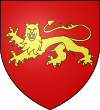 Lion passant guardant
Lion passant guardant
-
 Eagle argent
Eagle argent
-
 Swan gorged with a coronet
Swan gorged with a coronet
-
 Three salmon naiant
Three salmon naiant
-
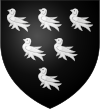 Six martlets
Six martlets
-
 Unicorn
Unicorn
-
 Griffin segreant
Griffin segreant
-
 Sea lion crowned
Sea lion crowned
-
 Salamander
Salamander
Animal parts
Animals' heads are also very frequent charges, as are the paw or leg (gamb) of the lion, the wing (often paired) of the eagle, and the antlers (attire) of the stag. Sometimes only the top half of a beast is shown; for example, the demi-lion is among the most common forms occurring in heraldic crests.
Heads may appear cabossed (also caboshed or caboched): with the head cleanly separated from the neck so that only the face shows; couped: with the neck cleanly separated from the body so that the whole head and neck are present; or erased: with the neck showing a ragged edge as if forcibly torn from the body. While cabossed heads are shown facing forward (affronté), heads that are couped or erased face dexter unless otherwise specified for differencing. Heads of horned beasts are often shown cabossed to display the horns, but instances can be found in any of these circumstances. A lion's head cabossed is called simply a face, and a fox's head cabossed, a mask.
Attitude of animals
Main article: Attitude (heraldry)The attitude, or position, of the creature's body is usually explicitly stated in English blazon. When such description is omitted, a lion can be assumed to be rampant, a leopard or herbivore passant.
By default, the charge faces dexter (left as seen by the viewer); this would be forward on a shield worn on the left arm. In German armory, animate charges in the dexter half of a composite display are usually turned to face the center.
- An animal toward sinister or contourny is turned toward the right of the shield (as seen by the observer, i.e. the shield-bearer's left), the sinister.
- An animal affronté or full faced faces the viewer.
- An animal guardant faces dexter with its head turned to face the viewer.
- An animal regardant faces dexter with its head turned toward sinister, as if looking over its shoulder.
Certain features of an animal are often of a contrasting tincture. The charge is then said to be armed (claws and horns and tusks), langued (tongue), vilené or pizzled (penis), attired (antlers or very occasionally horns), unguled (hooves), crined (horse's mane or human hair) of a specified tincture.
Many attitudes have developed from the herald's imagination and ever-increasing need for differentiation, but only the principal attitudes found in heraldry need be discussed here. These, in the case of beasts, include the erect positions, the seated positions, and the prone positions. In the case of birds, these include the "displayed" positions, the flying positions, and the resting positions. Additionally, birds are frequently described by the position of their wings. A few other attitudes warrant discussion, including those particular to fish, serpents, griffins and dragons.
The principal attitude of beasts is rampant (i.e. standing on one hind leg with forepaws raised as if to climb or mount - sometimes including an erect member). Beasts also frequently appear walking, passant or, in the case of stags and the occasional unicorn, trippant, and may appear statant (standing), salient or springing (leaping), sejant (seated), couchant or lodged (lying prone with head raised), or occasionally dormant (sleeping). The principal attitude of birds, namely the eagle, is displayed (i.e. facing the viewer with the head turned toward dexter and wings raised and upturned to show the full underside of both wings). Birds also appear rising or rousant (i.e. wings raised and head upturned as if about to take flight), volant (flying), statant (standing, with wings raised), close (at rest with wings folded), and waterfowl may appear naiant (swimming), while cranes may appear vigilant (standing on one leg). Fish often appear naiant (swimming horizontally) or hauriant (upwards) or urinant (downwards), but may also appear addorsed (two fish hauriant, back to back). Serpents may appear glissant (gliding in a wavy form) or nowed (as a figure-eight knot). Griffins and quadrupedal dragons constantly appear segreant (i.e. rampant with wings addorsed and elevated) and, together with lions, may appear combatant (i.e. two of them turned to face each other in the rampant position).
Plants
Plants are extremely common in heraldry and figure among the earliest charges. The turnip, for instance, makes an early appearance, as does wheat. Trees also appear in heraldry; the most frequent tree by far is the oak (drawn with large leaves and acorns), followed by the pine. Apples and bunches of grapes occur very frequently, other fruits less so. When the fruit is mentioned, as to indicate a different tincture, the tree is said to be fructed of the tincture. If a tree is "eradicated" it is shown as if it has been ripped up from the ground, the roots being exposed. "Erased" is rarely used for a similar treatment. In Portuguese heraldry, but rarely in other countries, trees are sometimes found decorticated.
The most famous heraldic flower (particularly in French heraldry) is the fleur-de-lis, which is often stated to be a stylised lily, though despite the name there is considerable debate on this. The "natural" lily, somewhat stylised, also occurs, as (together with the fleur-de-lis) in the arms of Eton College. The rose is perhaps even more widely seen in English heraldry than the fleur-de-lis. Its heraldic form is derived from the "wild" type with only five petals, and it is often barbed (the hull of the bud, its points showing between the petals) and seeded in contrasting tinctures. The thistle frequently appears as a symbol of Scotland.
The trefoil, quatrefoil and cinquefoil are abstract forms resembling flowers or leaves. The trefoil is always shown slipped (i.e. with a stem), unless blazoned otherwise. The cinquefoil is sometimes blazoned fraise (strawberry flower), most notably when canting for Fraser. The trillium flower occurs occasionally in a Canadian context, and the protea flower constantly appears in South Africa, since it is the national flower symbol.
Wheat constantly occurs in the form of "garbs" or sheaves and in fields (e.g. in the arms of the province of Alberta, Canada), though less often as ears, which are shown unwhiskered (though some varieties of wheat are naturally whiskered). Ears of rye are depicted exactly as wheat, except the ears droop down and are often whiskered, e.g. in the arms of the former Ruislip-Northwood Urban District. Barley, cannabis, maize, and oats also occur. The "garb" in the arms of Gustav Vasa (and in the coat of arms of Sweden) is not a wheatsheaf, although it was pictured in that way from the 16th to 19th century; rather, this "vasa" is a bundle but of unknown sort.
-
 Tree fructed and eradicated
Tree fructed and eradicated
-
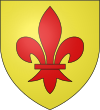 Fleur-de-lis
Fleur-de-lis
-
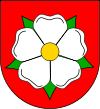 Heraldic rose
Heraldic rose
-
 Three trefoils
Three trefoils
-
 "Vasa"
"Vasa"
-
 Cannabis
Cannabis
-
 Three maple leaves
Three maple leaves
Inanimate objects
Very few inanimate objects in heraldry carry a special significance distinct from that of the object itself, but among such objects are the escarbuncle, the fasces, and the key. The escarbuncle developed from the radiating iron bands used to strengthen a round shield, eventually becoming a heraldic charge. The fasces (not to be confused with the French term for a bar or fess) is emblematic of the Roman magisterial office and has often been granted to mayors. Keys (taking a form similar to a "skeleton key") are emblematic of Saint Peter and, by extension, the papacy, and thus frequently appear in ecclesiastical heraldry. Because St. Peter is the patron saint of fishermen, keys also notably appear in the arms of the Worshipful Company of Fishmongers.
The sun is a disc with twelve or more wavy rays, or alternating wavy and straight rays, often represented "in his splendour" (i.e. with a face). The moon "in her plenitude" (full) sometimes appears, distinguished from a roundel argent by having a face; but crescents occur much more frequently. Estoiles are stars with six wavy rays, while stars (when they occur under that name) have straight rays usually numbering five in British and North American heraldry and six in continental European heraldry. Clouds often occur, though more frequently for people or animals to stand on or issue from than as isolated charges. The raindrop as such is unknown, though drops of fluid (goutte) is known. These occasionally appear as a charge, but more frequently constitute a field semé (known as goutté). The snowflake occurs in modern heraldry, sometimes blazoned as a "snow crystal" or "ice crystal".
The oldest geological charge is the mount, typically a green hilltop rising from the lower edge of the field, providing a place for a beast, building or tree to stand. This feature is exceedingly common in Hungarian arms. Natural mountains and boulders are not unknown, though ranges of mountains are differently shown. An example is the arms of Edinburgh, portraying Edinburgh Castle atop Castle Rock. Volcanos are shown, almost without exception, as erupting, and the eruption is generally quite stylised. In the 18th century, landscapes began to appear in armory, often depicting the sites of battles. For example, Admiral Horatio Nelson, 1st Viscount Nelson received a chief of augmentation containing a landscape alluding to the Battle of the Nile.
By far the most frequent building in heraldry is the tower, a tapering cylinder of masonry topped with battlements, usually having a door and a few windows. The canting arms of the Kingdom of Castile are Gules, a tower triple-turreted Or (i.e. three small towers standing atop a larger one). A castle is generally shown as two towers joined by a wall, the doorway often shown secured by a portcullis. The portcullis was used as a canting badge by the House of Tudor ("two-doors"), and has since come to represent the British Parliament. The modern chess-rook would be indistinguishable from a tower; the heraldic chess rook, based on the medieval form of the piece, instead of battlements, has two outward-splayed "horns". Civic and ecclesiastical armory sometimes shows a church or a whole town, and cities, towns and Scots burghs often bear a mural crown (a crown in the form of a wall with battlements or turrets) in place of a crown over the shield. Ships of various types often appear; the most frequent being the ancient galley often called, from the Gaelic, a lymphad. Also frequent are anchors and oars.
The maunch is a 12th-century lady's sleeve style. Its use in heraldry arose from the custom of the knights who attended tournaments wearing their ladies sleeves, as "gages d'amour" (tokens of love). This fashion of sleeve would later evolve into Tippet-style stoles. In French blazon this charge is sometimes informally referred to as manche mal taillée (a sleeve badly cut).
Spurs also occur, sometimes "winged", but more frequently occurring is the spur-rowel or spur-revel, which is said to more often termed a "mullet of five points pierced" by English heralds.
Crowns and coronets of various kinds are constantly seen. The ecclesiastical hat and bishop's mitre are nearly ubiquitous in ecclesiastical heraldry. The sword is sometimes a symbol of authority, as in the royal arms of the Netherlands, but may also allude to Saint Paul, as the patron of a town (e.g. London) or dedicatee of a church. Sometimes it is shown with a key, because Saints Peter and Paul are paired together. Other weapons occur more often in modern than in earlier heraldry. The mace also appears as a weapon, the war mace, in addition to its appearance as a symbol of authority, plain mace. The globus cruciger, also variously called an orb, a royal orb, or a mound (from French monde, Latin mundus, the world) is a ball or globe surmounted by a cross, which is part of the regalia of an emperor or king, and is the emblem of sovereign authority and majesty.
Books constantly occur, most frequently in the arms of colleges and universities, though the Gospel and Bible are sometimes distinguished. Books if open may be inscribed with words. Words and phrases are otherwise rare, except in Spanish and Portuguese armory. Letters of the various alphabets are also relatively rare. Arms of merchants in Poland and eastern Germany are often based on house marks, abstract symbols resembling runes, though they are almost never blazoned as runes, but as combinations of other heraldic charges. Musical instruments commonly seen are the harp (as in the coat of arms of Ireland), bell and trumpet. The drum, almost without exception, is of the field drum type. Since musical notation is a comparatively recent invention, it is not found in early heraldry, though it does appear in 20th century heraldry.
Japanese mon are sometimes used as heraldic charges. They are blazoned in traditional heraldic style rather than in the Japanese style.
-
 Anchor
Anchor
-
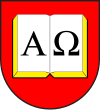 Book with letters
Book with letters
-
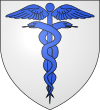 Caduceus
Caduceus
-
 Chess rook
Chess rook
-
 Three clarions
Three clarions
-
 Crown
Crown
-
 Escarbuncle
Escarbuncle
-
 Fasces
Fasces
-
 fire basket (heraldry)
fire basket (heraldry)
-
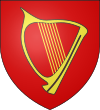 Harp
Harp
-
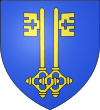 Keys addorsed
Keys addorsed
-
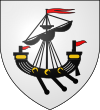 Lymphad
Lymphad
-
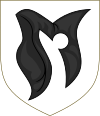 Maunch
Maunch
-
 Moon in her plenitude
Moon in her plenitude
-
 Portcullis
Portcullis
-
 Snow crystal
Snow crystal
-
 Spur
Spur
-
 Sun in his splendour
Sun in his splendour
-
 Sword
Sword
-
 Tower on a mount
Tower on a mount
-
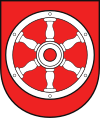 Wheel
Wheel
See also
Notes
- As in the coat of arms of the 432d Reconnaissance Group of the United States Air Force.
- Woodcock, himself apparently one such author, lists Leigh, Holme, Guillim and Edmondson among these, while other prominent authors such as Fox-Davies shun the distinction as an arbitrary and unuseful practice.
- Marks of cadency differ from country to country, but are largely the same in Britain and France, and similar in other European countries outside of the German-speaking (and Nordic) countries, where brisures on the shield were less common and different crests were often adopted to indicate the difference. It should also be noted that the English system of cadency, by which the use of the label to indicate the first son is best known, was not developed until the Tudor dynasty.
- See the arms of William de Valence, Earl of Pembroke in Fox-Davies (1909, fig. 120) for an example of this.
- The arms of Marija Bistrica depicting the black Madonna can be found at Heimer (2018).
- In his July 15, 2005 blog article "Is that a Moor's head?", Mathew N. Schmalz refers to a discussion on the American Heraldry Society's web site where at least one participant described the moor's head as a "potentially explosive image."
- See also Coats of arms of the House of Colleoni at Wikimedia Commons.
- The town of Waiblingen was granted arms in 1957 displaying a triple-headed eagle said to represent the dukes of Swabia, seen here, and the arms of Reinmar von Zweter, depicted in the Codex Manesse, can be seen here.
- 'Gyronny of eight ermine and gules - in each of the last four gyrons a bee volant en arriere argent' was recorded in the 1670s, well before Napoleon Bonaparte's time.
- An example of a tree "erased" can be found here.
- Any notion of a mushroom or "atomic cloud" is of relatively recent vintage.
References
- Maurer (1983), p. 303.
- Maurer (1983), p. 393.
- Maurer (1983), p. 21.
- Maurer (1983), p. 261.
- "961st Engineer Battalion". Archived from the original on 2016-08-13.
- Maurer (1983), p. 339.
- Maurer (1983), p. 163.
- ^ The UK Linguistics Olympiad 2018 on www.uklo.org
- ^ Fox-Davies (1909), p. 107
- ^ Woodcock & Robinson (1988), p. 58
- Woodcock & Robinson (1988), pp. 58–61
- von Volborth (1981), pp. 18–19
- Boutell (1890), p. 20
- Clark (1892), p. 16
- von Volborth (1981), p. 76.
- Woodward & Burnett (1894), p. 444.
- Fox-Davies (1909), pp. 295–296
- Fox-Davies (1909), p. 127
- Fox-Davies (1909), pp. 128–9
- Douglas, Robert (1764). The peerage of Scotland : containing an historical and genealogical account of the nobility of that kingdom, from their origin to the present generation: collected from the public records, and ancient chartularies of this nation, the charters, and other writings of the nobility, and the works of our best historians ... Edinburgh: R. Fleming.
- Parker, James. "Man". A Glossary of Terms Used in Heraldry. Retrieved 2012-01-23.
- ^ "Africans in medieval & Renaissance art: the Moor's head". Victoria and Albert Museum. Retrieved 2012-01-23.
- "Part IX: Offensive Armory". Rules for Submissions of the College of Arms of the Society for Creative Anachronism, Inc. 2008-04-02. Retrieved 2012-01-23.
- Woodward & Burnett (1894), p. 203
- Altieri, Ferdinando (1726). Dizionario italiano ed inglese: A dictionary Italian and English
- Neubecker (1976), p. 110
- Neubecker (1976), p. 83
- FXで儲けを得るための手段とは?.
- Pierre Mollier (2004). "The Double-Headed Eagle: iconographic sources of the masonic symbol" (PDF). The Chain of Union (Special issue No.3): 5–15. Retrieved 2011-10-30.
- Fox-Davies (1909), p. 242
- Cussans (2003), p. 93
- Jacqueline Fearn. Discovering Heraldry (1988 ed.). Shire Publications Ltd. pp. 35–6.
- MacKinnon, Charles (1966). The Observer's Book of Heraldry. Frederick Warne and Co. p. 67.
- Rietstap (1884), XXXI, "Vilené: se dit un animal qui a la marque du sexe d'un autre émail que le corps"; translating roughly to "Vilené: when an animal has its genitals in another color than the body"
- Velde, Francois R. "Sex in Heraldry".
- ^ Fox-Davies (1909), p. 291
- Maurer (1983), p. 372.
- Rietstap (1884), page XXV; Woodward & Burnett (1894), p. 376
- Fox-Davies (1909), p. 286
- Clark (1892), p. 164
- Tsubouchi, David Hiroshi (Canadian register of arms)
Bibliography
- Boutell, Charles (1890). Heraldry, Ancient and Modern: Including Boutell's Heraldry. London: Frederick Warne. OCLC 6102523 – via Internet Archive.
- Brooke-Little, J P (1985) . An heraldic alphabet (New and revised ed.). London: Robson Books. ISBN 9780860513209.
- Cussans, John E. (2003). Handbook of Heraldry. Kessinger Publishing. ISBN 0-7661-7338-0. LCCN 04024470 – via Internet Archive.
- Clark, Hugh (1892) . Planché, J. R. (ed.). An Introduction to Heraldry (18th ed.). London: George Bell & Sons. ISBN 1-4325-3999-X. LCCN 26005078 – via Internet Archive.
- Fox-Davies, Arthur Charles (1909). A Complete Guide to Heraldry. New York: Dodge Publishing. ISBN 0-517-26643-1. LCCN 09023803 – via Internet Archive.
- Heimer, Zeljko (9 December 2018). "Krapina and Zagorje County - Communities". The Flags & Arms of the Modern Era.
- Maurer, Maurer, ed. (1983). Air Force Combat Units of World War II. Washington, DC: Office of Air Force History. ISBN 9780-912799025.
- Neubecker, Ottfried (1976). Heraldry: Sources, Symbols and Meaning. Maidenhead, England: McGraw-Hill. ISBN 0-07-046312-3.
- Rietstap, J. B. (1884). Armorial général: précédé d'un Dictionnaire des termes du blason (in French). Vol. 1. G. B. van Goor zonen. OCLC 551247698 – via Internet Archive.
- von Volborth, Carl-Alexander (1981). Heraldry: Customs, Rules and Styles. Poole, England: Blandford Press. ISBN 0-7137-0940-5. LCCN 81670212.
- Woodcock, Thomas; Robinson, John Martin (1988). The Oxford Guide to Heraldry. Oxford University Press. ISBN 0-19-211658-4. LCCN 88023554.
- Woodward, John; Burnett, George (1894) . Woodward's a treatise on heraldry, British and foreign: with English and French glossaries. Edinburgh: W. & A. B. Johnson. ISBN 0-7153-4464-1. LCCN 02020303 – via Internet Archive.
Further reading
- Bureau of Heraldry. "Gallery". National Archives & Records Service of South Africa. Archived from the original on 2019-07-24. Retrieved 2019-07-24.
- Canadian Heraldic Authority. "Public Register of Arms, Flags and Badges of Canada".
- Friar, Stephen, ed. (1987). A New Dictionary of Heraldry. Sherborne: Alphabooks.—Some illustrations of attitudes
- Greaves, Kevin (2000). A Canadian Heraldic Primer. Ottawa: Heraldry Society of Canada.
- Heraldry Society (England). "Members' Roll of Arms".
- Heraldry Society of Scotland. "HSS Members' - Scots Arms". Archived from the original on 2013-05-07. Retrieved 2010-06-05.
- Innes, Sir Thomas (1956). Scots Heraldry (second ed.). Edinburgh: Oliver and Boyd.
- Moncreiffe, Iain; Pottinger, Don (1953). Simple Heraldry. London and Edinburgh: Thomas Nelson and Sons.—Many illustrations
- Royal Heraldry Society of Canada. "Members' Roll of Arms".
- Young, Robert (12 May 2005). "Civic Heraldry of England and Wales". Retrieved 24 July 2019.
External links
 Media related to Charges in heraldry at Wikimedia Commons
Media related to Charges in heraldry at Wikimedia Commons
| Heraldry | |||||||||||||||
|---|---|---|---|---|---|---|---|---|---|---|---|---|---|---|---|
| Types | |||||||||||||||
| Topics | |||||||||||||||
| Achievement | |||||||||||||||
| Charges | |||||||||||||||
| Tinctures |
| ||||||||||||||
| Applications | |||||||||||||||
| Related | |||||||||||||||
| |||||||||||||||
